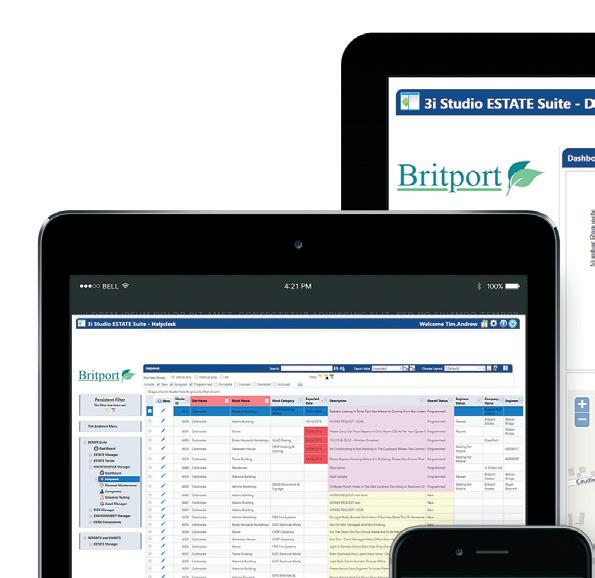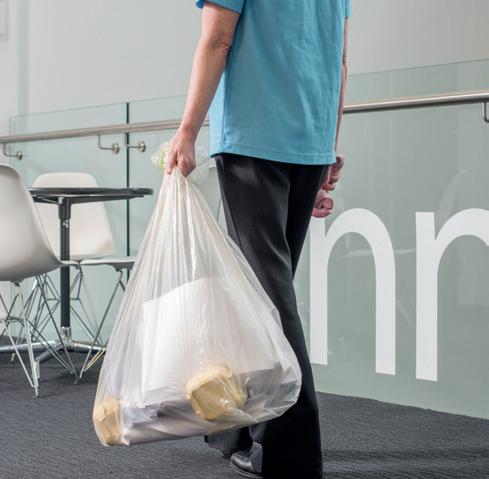

















AI powered virtual assistant
Multiple data streams at your fingertips with our single interface
Let our AI tackle your routine tasks and free up your resources
Enhance existing systems with our AI overlay & turn your data into a lucrative easily accessible asset


kpm media Unit 1 Mill Place, Platt Business Estate, Maidstone Road, Sevenoaks, Kent TN15 8TB Tel: 01322 662289
Editor Sara Bean sara.bean@kpmmedia.co.uk
Assistant Editor & Social Media Development
Sarah O’Beirne sarah.obeirne@kpmmedia.co.uk Tel: 01322 476815
Director & Designer Warren Knight warren.knight@kpmmedia.co.uk Mob: 0780 1947757
Sales Director Danny Grange danny.grange@kpmmedia.co.uk Mob: 07867 418994
Business Administrator Maxine Howell maxine@kpmmedia.co.uk
Accounts Diane Jarvis accounts@kpmmedia.co.uk
Group CEO Nigel Copp nigel.copp@kpmgroup.co.uk
Editorial steering committee
Alan Hutchinson, Facilities Director, Howard Kennedy LLP
Charles Siddons, Head of Operations, NHS Property Services
Darren Miller, NBCUniversal, VP for International Workplace, Facilities & Real Estate
Ian Wade, Head of UK Estates, British Medical Association
Lucy Hind, Senior FM Lecturer, Leeds Beckett University
Marie Johnson, Head of Workplace & Wellbeing, Nominet
Paul Cannock, Head of the Estates and Facilities Management Department, European Space Agency
Russell Wood, Senior Facilities Manager at Travers Smith LLP
Russell Burnaby, Head of FM, Regeneration and Environment, Brent Council
Simon Francis, Director of Estates and Facilities, The Institute of Cancer Research
Simone Fenton-Jarvis, Group Director of Workplace Consultancy and Transformation, Vpod Solutions
Wayne Young, Facilities Manager at DB Cargo (UK)
SUPPORTED BY


At the 2024 annual Workplace Futures conference (see report page 10) which explored the symbiotic relationship between people and technology, Paul Bullard from SFG20, the industry standard for building maintenance specification, asked whether digital data is currently being presented in a way people can understand and access.
He suggested that AI has a role in tailoring information to make it more accessible to people. Or, as the so ware experts at the conference agreed, if users aren’t confident in the solutions being o ered to them they’re not worth the investment.
The same sentiment resonated at a seminar (see page 16), which explored the application of AI and what it means for people and property. There, delegates were told that AI should be used as a tool rather than a panacea, which, as the Workplace Futures conference concluded, means it’s never about tech for tech’s sake, but what it helps you achieve.
While both events provided many useful insights into some of the digital developments coming down the line, the conclusion was that emerging technologies are only there to enable us to become more human centric.
For FMs this means providing a safe, comfortable working environment. In the case of the Environment Agency’s residential estates team, (case study page 24) this extends to delivering safe, secure and sustainable homes for the occupants of 45 tenanted lock keeper houses and seven privately let houses on the River Thames.
We were invited to visit one of the cottages to see for ourselves how the estates team are safeguarding historic riverside dwellings from the elements while applying green solutions that help reduce climate change.
It was a useful reminder that regardless of the use of digital tech, the vast majority of the built environment is ageing, and it will require some strategic thinking over the coming years to address all the challenges this brings.
© Copyright 2024 kpm media
The publisher does not necessarily agree with the views and opinions expressed by contributors. No material may be reproduced in part or whole without written permission from the editor. Editorial contributions are accepted on an all-rights basis only. Letters to the editor may be published in their entirety or in edited form and remain the property of kpm media. While due care is taken to ensure the accuracy of information contained in this magazine, the publishers cannot be held responsible for any errors in editorial articles or advertisements. Subscriptions are available to non-qualifying and overseas readers at £120 p.a. (UK), £160 p.a. (EU countries) and £240 p.a. (overseas-other).
As always, we’d welcome your feedback about any aspect of the magazine, together with your insight into what’s happening in the FM sector.
sara.bean@kpmmedia.co.uk

















Protect your most important assets with an annual fuel system inspection (FSI) carried out by our expert engineers.
With a suite of 60 in-depth checks that cover all aspects of your fuel system, an FSI protects your business and local environment against leaks, spills and fuel contamination.
Get in touch today to find out more.

BENEFITS OF AN EXPERT FUEL SYSTEM INSPECTION

Includes a 60-point checklist




Includes visual inspection, fuel testing & more End-to-end service UK-wide coverage for a range of sectors
Prevent problems before issues manifest
Find out more about our services here:








06
This month’s summary of everything that has hit the headlines in the FM sector.
08
The latest news and views from membership organisations.
10
Sara Bean reports from Workplace Futures 2024 People & Tech: A symbiotic relationship, which took place in London and online.






12

The Demand Flexibility Scheme (DFS) incentivises users to reduce their demand on the grid during peak periods. Aaron Lally of VEST Energy explains how it works.
14 From eco-improvements to fire safety
Rik Firth of Your Choice Fire & Security has advice on the changes to regulations likely to impact FMs this year.
16
In a recent Profile Network event hosted by JLL, technology leaders came together to discuss the transformative power of artificial intelligence (AI). Jo Sutherland reports.
18
Georgia Jordan of BioHygiene, on why it’s time to move away from the misconception that natural based cleaners don’t provide a better cleaning performance.
20
FMs are now realising the importance of focusing on employee development and wellbeing. Which areas should service suppliers and their clients be concentrating on to enhance both individual and organisational wellbeing?







24 Sara Bean visits one of the lock keeper cottages on the River Thames to see how the work being done by the estates team at the Environment Agency is benefiting occupants and the environment.
28 Penny Brinsley of Service Works Global explains how a permit to work system can o er various benefits, especially when integrated within a CAFM system.
30 Facilities managers can harness the power of a CAFM system that enables them to benefit from the flexibility of hybrid working, says Esther Coleman from Idox.
32 E ective maintenance of M&E assets is essential to the smooth running of any organisation. John Cooper from NG Bailey o ers some proven strategies.
34 The Building Security Assessment Scheme provides a distinctive quality benchmark, says Matthew Holliday of the National Security Inspectorate.
36 In January 2023 the Wates Group appointed experienced FM leader Antony Collett as Managing Director of its facilities management business. FMJ hears how it’s going.
40 The greenest building is the one that already exists, which is why the future is retrofit says Alice Murray, Head of Asset Management and Sustainability, Clearbell Capital.






51 Find out who’s moving where in the facilities management profession.
52 Harriet Stuchbury, Senior Consultant at LCMB on how SMEs within the FM sector can benefit from the Apprenticeship Levy Transfer scheme.
53 Jonathan Eland from PPL Training presents anecdotal evidence from recent client case studies on the training needs for SMEs and larger organisations.
54 A brief roundup of the latest careers news in the facilities management sector.
42 CIAT’s Matthew Maleki explains why Defra’s Expert Group Report on Indoor Air Quality provides guidance to the improvements that can enhance workplace wellbeing.
44
New product and service launches and company news from the FM industry.
In the April issue of FMJ we present the results of a special FMJ round table event which discussed the development of a digital and data-centric approach to managing building operations. There is a case study on the work of the Government Property Agency (GPA) –that manages nearly one million sq. m of the civil service workplace estate, delivering strategic planning and services including design, property technology and workplace experience. We explore the new framework published by the SFMI in collaboration with the SFMI Scope 3 framework Board that aims to help FMs provide sustainable solutions. And with the Fire Safety Act 2021 and the Fire Safety Regulations (England) 2022 forcing a shi in priorities and duties, we discuss how this could impact those working in facility management.
sara.bean@kpmmedia.co.uk
for your free copy of FMJ visit fmj.co.uk


New proposals will grant 200,000 businesses access to The Energy Ombudsman, but as a specialist law firm dedicated to energy litigation for businesses and households, we question whether these changes are enough.
The proposals suggest that small businesses will gain access to the Ombudsman’s services and be treated more like household consumers, but the legal experts say there is still plenty of work to be done.
The Energy Ombudsman is an independent body that should be able to get the supplier to revisit your complaint, decide whether the right decision was made, and where appropriate obtain financial compensation.
The proposed changes to expand the types of eligible businesses that can use the Energy Ombudsman is vital, given the current climate, but there are still thousands of businesses left without help.
Historically, only “micro-businesses” with less than 10 employees had access to the Ombudsman’s complaint process, however, with an 84 per cent increase in complaints last year, the need for better representation for businesses was identified.
Under the new proposals, companies with fewer than 50 employees will be able to take complaints to the Energy Ombudsman if they are unhappy with the behaviour of their energy supplier or are stuck in deadlock.
Minister for Energy Consumers and Affordability, Amanda Solloway, said: “This government has always stood by businesses, and we want to ensure they are getting proper support and service in dealing with energy suppliers.
“That’s why we’re proposing expanding the reach of the Energy Ombudsman to cover an extra 200,000 businesses, allowing them to access free, impartial advice and resolve issues with their supplier without the need for an expensive trip to court.”
The changes will expand the existing standards of conduct for suppliers and will give Ofgem the power to take action if suppliers behave poorly towards any business customer.
Common disputes include errors in the ways that bills are calculated, overcharging, commissions not being disclosed and the mis-selling of energy contracts.
While the Ombudsman should be able to help businesses with energy disputes, we’ve seen that this is not always the case, with dissatisfied businesses, disputes being rejected, or suppliers or brokers not registered on the Ombudsman’s scheme.
It is also worth remembering that the Ombudsman is impartial and subsequently will not help you to build your case or represent you, and we strongly advise that you do not attempt to instigate court proceedings by yourself.
If you’ve raised a complaint with your energy supplier, or the Ombudsman but you’re unhappy with their response, we can issue court proceedings on your behalf, if required, in what otherwise could potentially be a complicated dispute.
Field service management so ware provider, Totalmobile, has seen alerts raised through its Lone Worker Protection So ware soar in the last year, with the company handling a staggering 135,859 alerts from its 100,000 users.
The rise in alerts highlights the growing risks that lone workers, and those working in hostile environments, are facing daily in the UK. Findings from the British Crime Survey showed that 150 lone workers encounter physical or verbal assaults every day. More troublingly, the British Retail Consortium also reported that incidents of violence and abuse aimed at shop workers rose to 1,300 per day last year, up from 870 the year before.
Totalmobile’s team dealt with an average of 372 alerts per day last year, providing lone workers with an immediate response and assistance. These alerts came from customers in the public, commercial, and property sectors across the UK & Ireland who felt they were in danger and/or facing an imminent threat.

With up to eight million lone workers and an additional five million hidden lone workers operating in the UK, Totalmobile’s Chief Technology O icer, Jon Woodforth, commented: “As technology evolves, so do the challenges faced by lone workers. These latest figures serve as a stark reminder of the importance of our mission in bettering the lives of field workers and prioritising our customer’s safety in all our endeavours.”
Global workplace experience and facilities management firm, ISS, has reported a “solid delivery” in its full year results for 2023.


Business momentum was maintained during the last part of 2023, with organic growth of 7.1 per cent in Q4 2023 (Q4 2022: 10.1 per cent) and 9.7 per cent for the full-year 2023 (2022: 8.4 per cent), which ISS states was primarily driven by price increases and underlying volume growth. Total revenue for the quarter amounted to DKK 20.4 billion (£2.34 billion).



The underlying operating margin (excl. impact of hyperinflation in Turkey) improved to 4.6 per cent for the full-year 2023 (2022: 4.0 per cent) and 5.5 per cent in H2 2023 (H2 2022: 4.8 per cent). One-o costs of DKK 233 million (£26.7 million) related to the review of OneISS initiatives were recognised in H2 2023, resulting in a reported operating margin of 4.3 per cent for 2023.
ISS secured a new key account IFS contract with the Danish Building and Property Agency as well as several smaller and mid-sized IFS key account contracts across the Group. In the beginning of 2024, the global contracts with Nordea and an Industry & Manufacturing customer were extended, supporting a continued strong customer retention rate of 95 per cent.
ISS reports it has signed an agreement to divest the French business, which is progressing as planned with expected completion in H1 2024. The company has also said that the integration of Grupo Fissa in Spain is now complete.
For 2024, ISS expects organic growth to be 4-6 per cent, with operating margin expected to be above five per cent.

The British Safety Council has published an introductory guide for employers on managing the risks from storing and charging Lithium Ion (Li-on) batteries in the workplace.
Most e-bikes are powered by Li-on batteries, larger versions of the kind found in our smartphones, tablets, and some laptops.
In a recent, UK-based survey of users (and potential users) of e-bikes, 40 per cent of current users commuted to (and from) a place of work, with 20 per cent having used them for business travel.
Over the last six months batteries have regularly made headlines, with tragic stories of fires and explosions, resulting in injury and loss of life. Many of these were traced back to the charging of Li-on e-scooters and e-bikes.
Questions have therefore arisen around how we use, charge, and store e-bikes in the workplace – and the additional hazards and risks that this may bring.
The British Safety Council’s introductory guide recognises the challenges posed by the storage and charging of lithium-powered e-bikes and scooters in the workplace and provides employers with some tips to help mitigate the risks.
To download the free guide ‘Storing Lithium-ion batteries in the workplace’ visit https://bit.ly/4bVfIWb
be urged to tackle in-work sickness and stop people falling out the workforce, following the appointment of Dame Carol Black as the Government’s new Occupational Health Tsar.
Dame Carol, who has decades of experience in medicine and policy advisory while having chaired multiple government reviews, will head up a Taskforce that will produce a voluntary occupational health framework for businesses – which will include setting out minimum levels of occupational health needed to stop sickness-related job losses, and help businesses better support those returning to work a er a period of ill-health.
Just 28 per cent of employers in Britain provide some form of occupational health, with large employers (89 per cent) nearly three times more likely than Small-Medium Enterprises (SMEs) (28 per cent) to do so.
This much needed framework – expected this Summer – will form part of the Government’s drive to reduce inactivity levels and waiting list times.
The Taskforce aims to increase access and uptake of occupational health through:
Increasing information and visibility for employers on occupational health and the benefits of quality occupational health provision in retaining employees in the workplace.
Empowering employers to play an active role in improving employee health.
Removing barriers by focusing on SMEs with restricted finances and by ensuring that the Framework is applicable across sectors.
Complementing other existing health and disability workplace initiatives, including where occupational health is required in law.
Facilities Show, FIREX, IFSEC and Safety & Health Expo will now become part of newly launched Anticipate London, taking place 2-4 December 2024 at ExCeL London.
Exhibition organiser, Informa Plc, says the rebrand to Anticipate London, emerged as a result of insightful conversations with members of a future-focused advisory board which includes leaders in security, safety, FM and property from both FTSE 250 organisations and the wider public sector.
These professionals, says Informa, find themselves navigating a common landscape of challenges and opportunities such as tech innovation and digitalisation, emerging societal and global risks, climate change and government legislation, as a result of the discussions it became evident that to better address these macrolevel issues, a new forum was needed to bring leaders of property & people together and showcase solutions that create a safer, smarter future for all. Both the audience and the topics covered will have an international focus, with global themes represented.
Chris Edwards, Group Director of Anticipate London commented: “Our new exhibition for 2024 embraces a fundamental shi in the markets we serve, where many historically defined job roles and responsibilities have become blurred. Global events such as COVID-19, as well as changes in work patterns and climate change have catapulted people and property leaders to the forefront of business strategy.”



safe to say that sustainability and net zero remain top priorities for organisations across the world. However, recent research conducted by Institute of Workplace and Facilities Management (IWFM) suggests that workplace and facilities management (WFM) is not as involved as it can, or should, be in work around energy and carbon plans.
Taken from the Sustainability Survey Report 2023, conducted by IWFM in collaboration with our Sustainability Special Interest Group (SIG), research found that one in three facilities managers were ordinary stakeholders at best when drawing up energy e iciency and carbon reduction plans, with some not being involved at all. Meanwhile just 13 per cent of facilities managers led the entire process of developing plans.
With the essential input of 620 professionals
across WFM, the research found both strengths and shortcomings around WFM’s involvement in energy and carbon reduction plans. For instance, a lack of leadership was a key theme, with the third and fourth most common responses to a query around the weaknesses FMs see in organisational plans were that ‘there isn’t clear internal ownership or responsibility for delivery’ and ‘there isn’t the necessary understanding or support within senior levels’.
Additionally, 36 per cent of survey respondents identified a lack of funding or resources as a weakness in their organisations’ energy and carbon plans. However, survey respondents were in no doubt about the positive impact WFM can have on sustainability; on average, WFMs identified six ways in which they can add value around energy and carbon.
To make energy and carbon plans more successful in future, IWFM calls for extensive engagement with facilities managers in energy and carbon management, requiring a shi in mindset and proactive leadership in organisations.
The Institute of Hospitality (IoH) has successfully delivered the first 12 months of its three-year £160,000 (20232025) Diversity, Equity, Inclusion and Belonging (DEIB) strategy for its members and hospitality sector.

Furthermore, current investment processes are unsuitable for the opportunities and challenges that lie ahead. To this end, facilities managers need improvements to the investment process, better data and support to drive meaningful change in sustainability.
For facilities managers, it’s vital to take ownership, collaborate and advocate for sustainability within the organisation. Concurrently, organisational leaders should recognise the paramount importance of WFMs in their energy and carbon plans and help unblock the investment process. Lastly, at IWFM, we’re providing the guidance, training and advocacy for WFM which can drive positive change for people, planet and organisations.
To that end, following the report’s launch, we hosted a ‘Navigating turbulent times’ webinar to discuss the report’s findings in more detail and impart actionable insights to the community.
For a copy of the report go to https://bit.ly/4bUsK6u




CEO Robert Richardson FIH MI reports: “When we put our DEIB strategy together we aimed to create a fair and inclusive environment that was as diverse and accessible as the industry it represents. Our strategy focused on normalising diversity, from mental health to belonging, and everything in between, whilst providing education to our members and wider hospitality family, helping to support them to make their businesses as diverse and accessible as possible, wherever they might be in the world.
“Change can’t be accomplished overnight but we are all working hard to make this happen. This process is continuous. All our daily activities including our podcast which is accessed in over 54 countries, ensure we facilitate and celebrate the diversity across our eclectic industry.”
With a range of initiatives already underway and planned for 2024, including a DEIB Glossary, research, webinars and thought-leadership articles including Generational Diversity, Black History Month, Menopause and How to Avoid Tokenism in the Workplace, the Institute is working towards creating a level playing field for its membership and industry.
IOSHhas been invited to join the Global Coalition for Social Justice launched by the International Labour Organization (ILO) in November 2023. The Coalition and its partners were highlighted by the ILO and others as part of World Day of Social Justice on Tuesday 20 February 2024.
With a growing number of partners, including governments, employers’ and workers’ organisations, numerous United Nations (UN) system agencies, and international NGOs, this Coalition aims to play a crucial role in accelerating progress towards the 2030 Agenda, Sustainable Development Goals, and the Decent Work Agenda.
Said Vanessa Harwood-Whitcher, Chief Executive, IOSH: “Our decision to join the Global Coalition and lend our support and leadership in matters related to occupational safety and health (OSH) aligns with our overall vision of a safe and healthy world of work. At IOSH we believe strongly in collective action to address global issues and achieve equitable and sustainable outcomes for people and the planet. This new worldwide coalition will serve as a platform to generate increased political commitments, foster concrete actions in support of national priorities towards advancing social justice and decent work –committed to leaving no one behind – and create a forum for exchange and dialogue.”

You may already have your smoke control system maintained by Colt. And other dampers serviced elsewhere.
Colt can save you money and time.
Streamline your smoke control and damper maintenance management, while eliminating the need for secondary contractors and call-out charges. Colt can take care of all your smoke control and damper servicing needs in one package.

Your legal obligation.
Fire and smoke dampers play a very important role in a building’s fire safety system and under the Regulatory Reform (Fire Safety) Order 2005, it is the legal duty of the ‘Responsible Person’ in your company to oversee their maintenance and testing. It is imperative that your dampers are maintained properly by a competent company.
Colt is just such a company.

The benefits of a service contract with Colt.
Colt is the UK’s leading and largest supplier of smoke control maintenance and as such, we have the largest team of engineers stationed up and down the country. Our team is dedicated to delivering quality service 365 days a year, 24 hours a day.
As well as getting you the UK’s most competent engineers, the Colt service contract comes with a whole host of other valuable benefits.
One call is all it takes to find out more. Call 02392 491735, visit coltinfo.co.uk/service-maintenance.html or email service@uk.coltgroup.com




Workplace Futures 2024 focused on the symbiotic relationship between people and technology, which for FMs means delivering a quality workplace experience

The meshing of the physical and digital worlds was a theme that ran through this year’s Workplace Futures conference. Simone FentonJarvis took over as an able in person chair, with longstanding chair Martin Pickard joining online with a coterie of remote delegates for the Q&A sessions.
Katherine Harvey from Unwork began with a description of two new typologies; the rise of placemakers in the physical o ice and the widespread adoption of digital workplace experience apps. People want the chance to mix with their colleagues she explained - so ‘team huddle’ spaces are a popular way of enabling teams to connect, discuss and collaborate in immersive hybrid environments. The major trend of 2024 she concluded will be a push for a ‘return on experience’ that supports recruitment and retention.
Leanne Lynch from ISS, said she couldn’t think of a better industry than FM to explore the digital driven working environment, while remaining human centric. Using tech to gain an understanding of the rhythm of the building and the people who go there
you’ll find better ways to operate the building and discover what drives people into the workplace.
Adding a note of caution, David Sharp, CEO, International Workplace questioned whether removing friction by automating our workplaces is really a good thing. Has the friction really been removed, or has it just been hidden from sight and who are the people we don’t see behind the technology?, he asked.
Lara Al Ansari and Brad Taylor of AWA research into the use of AI for recruitment included some useful tips – with arguably the most pressing one being to engage with people now to educate them on the e ects of AI, not least to reassure them that AI won’t replace them in the future.
Though recruitment and retention expert Tim Cook CEO, of nGAGE TALENT pointed out, “you won’t be replaced by AI but by someone who knows what it is.” The main problem in many organisations is corporate lag he explained, where the people running the companies have very little idea of what’s coming down the track and
covering the three enablers, physical, colleague and digital.
Moving from the client FM to the provider’s view, Mark Hill of Sodexo described the challenge of moving beyond policy to one which values human interaction in a workplace setting. And it’s here where it is vital to foster cross organisational collaboration among the disciplines, encompassing, HR, DE&I, Real Estate and of course FM/ Workplace.
Providing the so ware expert’s perspective, Mats Broman, Marc Watkins, and Hazel Bedson of Service Works Global (SWG) noted that too o en tech being used to streamline operations is just there to reduce costs. It would be better used to provide meaningful data that helps drive decision making processes. Valuable insights by people running facilities can’t be replaced overnight but it can give them more confidence in the data. It’s not about the tech but what you can achieve from it.
with the genie now out of the bottle, the impact of AI and algorithms can no longer be ignored he concluded.
We are sleepwalking into skills stagnation, warned Linda Hausmanis, CEO of the IWFM in an impassioned diatribe on the failure of so many employers to tap into the unused skills of their sta . She argued that no matter what technology is used, there is always a human being at the heart of service delivery which for the FM sector means having access to people with the right skills.
Facilities has seen a lot of brand changes over the past few years, and the latest incarnation is Experience Manager. David Howorth, Global Colleague Experience Lead at BP said there are a lot of doubters in our industry that see the experience side of FM as the flu y stu , but workplace experience makes good business sense. To achieve this, is as much about fostering a leadership culture as it is providing a first-class workplace environment. No matter the size of the organisation, there is a need for skilled ‘corporate experience’ professionals
Matt Chapman and Kelly Dolphin from SBFM, which won the annual i-FM Technology in FM Award for Optimise AI - a sophisticated computer program trained using SBFM data to help answer day to day questions from its 7,000 sta , posed the simple question, ‘how well do you know your sta ?’ Using the tech to get the back story on front line workers o en the hidden figures in FM is key, and they were keen to share this blueprint for ways to enhance human connection.
It’s not just humans but animals who benefit from the latest security tech at London Zoo said Kieran Mackie of Amulet Security and Kelly Wessell, Security and Resilience Manager, at ZSL. A er installing CCTV to improve the security at the 27,000 sq site, they’re now using the equipment to help monitor animal welfare inside the enclosures and improve the visitor experience. A great example of tech that does so much more than make people safe.
As Lucy Jeynes concluded in her round up of the day and call to action – it’s the human part of the puzzle that makes the technology worth doing, by using the emerging technologies to enable us to become more human centric.
www.workplace-futures.co.uk
Most people would walk away, we’re not most people.

Jordan arrived at an elderly customer’s house and found the customer struggling to get into the family car due to a flat battery.
Jordan managed to open the door and pull the handle inside to gain access. He then popped the bonnet and jump-started the car from his van. He got the car running again and then went to unblock the drain.
To find out about our other services go to www.metrorod.co.uk
Complete water in, waste out solutions.
The new Demand Flexibility Scheme incentivises businesses to reduce their energy consumption. It’s a game changer, says Aaron Lally, Managing Partner at VEST Energy

While the public was focused on scare stories about potential blackouts this winter, the National Grid rolled out a new fund to ensure the lights stayed on across the country.
The Demand Flexibility Scheme (DFS) incentivises businesses and households to reduce their demand on the grid during peak periods. Essentially, companies can get paid for using less energy. This helps the electricity network to flatten out spikes and significantly reduces the risk of blackouts.
This scheme is a game changer for the energy flexibility market and is incredibly lucrative for businesses. For just a short amount of time, at set periods throughout the winter, businesses can earn a significant amount of revenue for very little inconvenience. And this is especially true for businesses which have energy storage on site.
Over the winter – designated as November to March - there will be at least 12 periods of time known as ‘events’, when the National Grid will ask businesses and homes to stop drawing energy from the grid. This will be at times when demand is exceptionally high, likely between 4pm – 7pm - and for short periods, typically an hour.
Each event could last up to four hours, but a business doesn’t have to participate for the full duration. The minimum period is 30 minutes - you
get paid for the length of time you take part and the amount by which you reduce your site’s energy consumption. National Grid has quoted this as £3,000 per megawatt-hour (MWH).
We’ve already seen eight events taking place this winter, with some returns being at a higher price than we anticipated, and it looks likely that we’ll see more than 12 events this winter in total. It’s super flexible. A business can participate in all events or decide in advance if a session is not feasible. You’re not penalised if you don’t take part – you just won’t be paid if you choose not to.
While this all sounds enticing, for some companies the challenge is how to square the circle – a er all, you need energy for your day-to-day operations. This is where battery energy storage comes in. Any business with a battery energy storage system (BESS) can store the energy they need in advance and draw on that energy during the DFS event. E ectively, the BESS acts as an energy reservoir, meaning you can continue operations as normal while still reducing your grid energy consumption. This means no interruption to operations, no turning the lights o or stopping equipment from running - but still knowing that they will be paid at the end of the period.
A standard BESS from the likes of UK provider Connected Energy has a 300kW capacity, meaning
it can generate £1,000 of revenue per DFS event. The systems are modular so companies can easily multiply the benefits. VEST Energy works with Connected Energy’s customers to make it simple for them to take part in this market.
So far this winter, there have been eight ‘events’ meaning a company with a Connected Energy system could have earned £8,000 by taking part.
“For many years, our customers have been using our battery energy storage systems to participate in grid balancing services,” says Nigel Dent, Head of Sales, Connected Energy. “But the Dynamic Flexibility Scheme makes it so much easier for businesses to benefit.”
The VEST Energy technology integrates with Connected Energy’s E-STOR battery energy storage system. This means that for facilities and building managers, there is very little resource required to make it work.
“With alerts provided in advance, we can ensure that the battery system is fully charged to take advantage of the event,” says Dent. “Our customers don’t need to do a thing and will only know they have taken part when they receive their payment at the end of the month.”
DFS is just one of several ways that businesses can make money from their BESS. This is definitely the start of more schemes to come. The regulatory environment is becoming more and more proflexibility and the direction of travel suggests more schemes will be launched. Businesses will be financially rewarded if they can provide flexibility to the grid – and that’s what energy storage can give them.
We also see another opportunity around electric vehicle charge points. “Higher powered chargers are coming and they o en require more energy than the grid can provide,” says Dent. “A battery energy storage system can deliver that additional power when needed, removing the need for an expensive grid infrastructure upgrade. With just a little bit of planning, the site can still participate in DFS or other schemes, meaning that the energy storage system becomes a revenue generator as well. We’ve done modelling with VEST for some clients and found they could easily earn up to £15,000 a year in this way.”


With Kingspan Light + Air, you can enjoy peace of mind and enhanced visibility about the status of your system at all times. Our SmartServ Pro remote monitoring system can enable remote system management and maintenance, reducing call-outs and saving you money and time.
Failure of a single element can impact the effectiveness of your system, potentially resulting in complete breakdown and unsafe conditions in your building. Therefore, it should be regularly tested and maintained. This is a legal requirement and should be done by a competent technical professional.
Our dedicated team of engineers work with clients to regularly inspect and test smoke ventilation systems to ensure that they are working properly and are fully compliant with local regulations. We understand that each building is unique and that’s why we tailor our maintenance plans to meet your specifi c needs. We offer a range of packages, including both annual and multi visit annual contracts for smoke ventilation system maintenance.

Talk to us about a service contract
Our experts are available nationwide 24/7, 365 days a year to respond to system failures and call out requests. They are also equipped to perform remedial works and preventative refurbishment to replace older or broken equipment as they carry a comprehensive stock of spare parts.
Kingspan Light + Air
T: +44 (0) 29 2077 6160 E: KLAUKServices@kingspan.com
www.kingspan.com/gb/en/business-groups/kingspan-light-air







In the wake of the Grenfell disaster, the Government introduced the Building Safety Act 2022 which represents the latest phase in the e ort to reduce the risk of a repeat occurrence of the fire. Rik Firth, Head of Operations at Your Choice Fire & Security on this and the other changes to regulations likely to impact FMs
We’ve already started to see this in buildings we manage in the logistics and manufacturing sector, insurance providers are demanding a much higher standard of fire protection systems in place. This is a natural response to the rising cost of goods and labour in the UK. To maintain their margin, and protect their liability they are requiring a minimum of P1 fire classification.
The P1 category is the highest of the property protection certifications. The di erentiating factors between a P1 and a P2 is that with a P2 not all areas are covered. A P1 category fire detection system ensures that a building has total fire protection. O en reserved for museums and listed buildings where damage to the building is just as important as the goods within.
The main reason for doing this is that if a fire broke out, and consumed much of the goods in a warehouse it would cost the insurers hundreds of thousands of pounds. By demanding that the fire protection covers all goods, insurers are reducing the risk and the probability that they will have to pay out.
Of course, upgrading a fire alarm to a P1 can be a costly project. But if not done, or if not done by a by a BAFE qualified team, it could invalidate your insurance. A disaster for Facility managers who guarantee peace of mind and complete protection for their clients.
BAFE are one of the top accrediting bodies in the UK, they ensure that all installers are maintenance providers are fully qualified and trained. Demanding they pass a rigorous enrollment process. BAFE will also help you find a recommended provider through their website.
The UK Government have a net zero target to hit, more specifically to reduce all direct emissions from public buildings by 50 per cent and 75 per cent by 2032 and 2037 respectively. All UK emissions are to reach net zero by 2050. The Government has submitted several amendments to this target in recent years. With pressure mounting from the public, these are more likely to be brought forward than pushed back.
This is most likely to result in FMs and building

In association with

www.yourchoicefireandsecurity.co.uk
managers being forced into adopting environmental improvements to their buildings to improve emissions. The easiest solution is to install solar panels which not only drastically reduce a building’s energy consumption but become cost e ective in as little as three years for many businesses.
Solar panels have their own regulations which demand regular maintenance to ensure they are still performing as expected, and are still safe for use in public buildings. While solar panels are inherently safe, all electrical works comes with risk. Electrical fires are some of the most common in o ices and residential buildings - it was in fact an electrical fault in an appliance that caused the fire in Grenfell Tower.
To avoid this our recommendation would be to use a NICEIC accredited installer. Similar to BAFE, it means they have passed rigorous inspection and have to abide by the highest standards.
In 2022, the UK Government banned combustible materials for use in construction. This included MCM (metal composite materials) cladding panels with an unmodified polyethylene (PE) core on all new buildings. These changes meet recommendations from phase one of the Grenfell Tower inquiry.
The Grenfell Tower Inquiry panel’s final report is likely to be published in the later part of 2024, which means we should see a new wave of compliance changes relating to cladding products, active and passive fire safety measures and management of buildings.
We’re also likely to see changes to 2005’s Compliance RRO (Regulatory Reform Order) and Fire Risk Assessment in response to the recommendations made by phase two of the panel.
The best way to get ahead of the regulatory changes is to ensure your fire system is up-todate and within the recommended manufacturer lifespan. Facilities managers are also recommended to have regular maintenance scheduled by a BAFE recommended maintenance partner, so get a site visit booked in, and ensure your buildings meet all the current requirements, and are a ected the least when the compliance changes come into e ect.

Pelsis' new intelligent insect light trap gives real time insights and data access, when and where you want it.
Monitor flying insect activity remotely in real time with our easy-to-use app and web platform.










Reliable notifications at your fingertips allow early intervention and increased customer satisfaction.
Delivers an easy technician experience with reduced ladder usage and more productive time on site.
The all-new intelligent insect light trap from Pelsis. Pest monitoring made simple.





Jo Sutherland, MD, Magenta Associates reports from a seminar on the Application of AI:
In a recent Profile Network event hosted by JLL, technology leaders came together to discuss the transformative power of artificial intelligence (AI) in various industries, particularly focusing on its implications for people and property management. With insights from Ross Powell, EMEA Head of PAM Technologies at JLL, Ben Yexley, Head of Business Development at Askporter, and Daniel Cooper, CoFounder & CTO at Jitty, the seminar explored how the use of AI has already begun to transform the way the property industry works.
Ross Powell initiated the discussion by addressing common misconceptions surrounding AI. Despite its ubiquitous presence in our daily lives, AI o en evokes fear and scepticism due to its portrayal in popular culture. From 2001: A Space Odyssey (1968) that features HAL 9000, a sentient supercomputer that, although not inherently evil, malfunctions and tries to eliminate the human crew, to the more recent I, Robot (2004) that depicts a dystopian future where robots exhibit unpredictable behaviour and kill humans, these films and others have contributed to the popular perception of AI as a potentially
dangerous and life-threatening (or at least life-altering) force that sits outside of our control. While they are works of fiction, they arguably reflect societal anxieties and ethical dilemmas surrounding the development and deployment of AI technologies.
This is not a fair or balanced foundation. Powell emphasised that AI is not a standalone entity but rather a tool that evolves alongside humanity. JLL, being at the forefront of technological innovation, has been integrating AI since 2016, particularly focusing on environmental control, data analysis, and enhancing customer experiences in commercial properties.
Powell highlighted JLL’s groundbreaking AI initiatives such as HANK, an innovative sustainability solution powered by AI to deliver fast energy savings and ROI. HANK uses machine learning, energy modelling, and outside data sources to make real-time micro-adjustments and continuously optimise HVAC equipment, reducing energy consumption and costs by 20 per cent. With an ROI guarantee, HANK’s algorithms optimise building environments for comfort and e iciency, and save money in the process. This was the first example of how AI can deliver

tangible benefits by analysing factors such as temperature, air quality, and occupant behaviour.
The second example is JLL’s GPT. JLL introduced its own version of the language processing tool, revolutionising its business operations with advanced language processing capabilities and real-time insights for its team who are encouraged to experiment with the platform. The amount of time that has been saved from the platform that specialises in JLL’s business landscape and the property sector has made the investment worthwhile.
The event also featured case studies demonstrating the practical applications of AI. Ben Yexley took to the stage to remind the audience that managing places and real estate assets is time-consuming, high-risk and human resource intensive… without tech, that is. askporter, an AI assistant and communication platform for real estate management, was founded out of the belief that human time is precious. Its mission is to enable people to interact with their real-world environment e ortlessly by managing people and places autonomously with AI. Yexley’s passion that no customer should have to sit in an endless call queue and that no team member should have to respond to the same questions repeatedly became increasingly apparent. Humans are meant for more, he argued.
One notable example of where this has become a reality is Legal and General A ordable Homes. Its web assistant helps occupants find out what’s going on when things go wrong by referencing the centralised database that doubles up as an inbuilt library of information. It also teaches people how they can fix problems themselves by showing them helpful
videos that relate to the problem in question. Where a visit is required, the web assistant will automatically allocate the work to the relevant provider, stamping the diagnosis clearly to ensure the delivery of a first-time fix. And that is why the platform has streamlined operations, reduced turnaround times, and enhanced customer service.
In a fireside chat, Daniel Cooper from Jitty emphasised the potential of AI in revolutionising industries like the housing market, particularly in data extraction and analysis. With advancements like GPT-4 and Google’s Vertex, AI promises to unlock new possibilities by structuring vast amounts of unstructured data e iciently.
However, despite the immense potential, challenges remain, including concerns about data privacy, resource allocation, and the need for e ective change management strategies.
As the event concluded, speakers o ered practical advice for industry leaders apprehensive about embracing AI. Powell stressed the importance of focusing on the value proposition rather than getting lost in technical jargon. Yexley urged a cautious approach, emphasising the importance of starting small and gradually scaling AI implementations to reap e iciency gains. Cooper echoed these sentiments, highlighting the need for investment in change management and emphasising AI as a tool rather than a panacea.
In conclusion, the event underscored the transformative potential of AI in reshaping industries and enhancing human experiences. By embracing innovation, leveraging AI technologies, and fostering a culture of adaptation, businesses can navigate the complexities of the digital age and unlock new opportunities for growth and development.




Our PartnerCare commitment means we prioritise sharing our expertise - in service, support and product recommendation - above everything else.

For over 20 years, our dedicated roofing experts have built trusted relationships with thousands of customers nationwide, manufacturing quality roofing systems and providing experienced, unbiased technical advice to help you to make the best decision for your asset.




@UKGBC To drive #EmbodiedCarbon reductions across the built environment, we need stronger regulation from government. We need mandatory measurement of whole life carbon, progressive limits on emissions & planning reforms that prioritise reuse. Learn more: https://ukgbc.org/resources/ embodied-carbon-modelling-and-reporting/
Jo Bishop MBA linkedin.com/in/ jobishopgirlgeek - Head of Estates Information & Systems at University of Warwick - It is so healthy to hear others sharing your challenges and direction of travel - gives you a sense of not being alone and that your vision is not complete madness. I was part of a great panel discussion today with Facilio and Facilities Management Journal (FMJ) which will be featured in a future issue. #Data #IoT #NetZero #expertpanel #cafm #iwms #CPIP #software #FMJ

Workplace Trends www.linkedin.com/ company/workplacetrends/ With less than two months to go until our Spring Summit, already a third of the in-person tickets have been booked. Here’s a sneak peak at who’s already registered - https://lnkd.in/ eWE5iy3N

@IWFM_UK We’re seeking dedicated #workplace and FM professionals to #volunteer with us and help make a difference to the profession. #facman Register your interest > https://ow.ly/ VFEe50QGz2K
@H_S_E Find out where asbestos can hide in the workplace and check if you have the duty to manage asbestos.
Learn more: https://bit.ly/3P2Gfak
Antony Slumbers linkedin.com/in/ antonyslumbers - How is generative AI poised to transform human-centric real estate and shape the future of workspaces? https://bit.ly/49Re864
Security Industry Authority https:// www.linkedin.com/company/securityindustry-authority/ Have you done your ACT e-Learning? Action Counters Terrorism (ACT) Awareness and ACT Security are now available in one place on the ProtectUK website Visit the ProtectUK hub for ACT e-learning: https://orlo.uk/azLkn


Responding to the widespread growth of the environmental movement, many cleaning products are adopting visible eco-initiatives like minimising plastic waste and addressing transport-related Scope 3 emissions. While monitoring transportation is important in tackling the carbon crisis, gaining insight into a product lifecycle is crucial for informed decision-making, towards achieving environmental targets.
Because traditional cleaning products use ingredients sourced from petrochemicals, which begin their lives being mined to then be converted into cleaning chemicals like formaldehyde, many commonly used cleaning products retain a large carbon footprint.
When thinking of chemical pollution in our water, most envisage multi-billion-dollar corporations dumping barrels of chemicals into our waters. In reality, post-use of petrochemical cleaning products also has detrimental e ects on aquatic life. A er use, these chemicals enter our water cycle adding to the aquatic toxicity crisis.
For example, phosphates in our waters promote the growth of algae, which deprives that area of oxygen, creating aquatic dead zones.
In recent years, clean, sanitised spaces have been crucial for public health. However, the focus on cleanliness must consider the impact these cleaning products have on the user’s health. A 2018 study revealed that long-term inhalation of traditional cleaning products emulates the respiratory impact of smoking a pack of cigarettes a day. But there are many more health implications associated with petrochemicals and its user:
» 2-Butoxyethanol: Can a ect the health of red blood cells.
» Phthalates: Impact reproductive function, and cause DNA damage.
» Parabens: A ects breasts, hormones, and reproductive areas.
» Chlorine Bleach: A potent antimicrobial and respiratory irritant.
Ensuring the safe use of petrochemicals in the workplace requires comprehensive user understanding and proper PPE provision. This can be challenging for FMs to maintain consistent safety standards amid an industry with high sta turnovers and language barriers that o en cause discord in safety procedures like ensuring correct
dilutions.
Maintaining clean, inviting spaces is vital, but not at the expense of employee health. By contrast, alternative eco-focused products, such as BioHygiene, use a synergistic combination of renewably and sustainably sourced ecotechnology and biotechnology that achieve a superior cleaning performance with a much lower carbon impact. Ingredients achieve a 75-100 per cent carbon reduction compared to traditional technology, with savings as high as 1.3kg CO2e / L, equivalent of 475ml of crude oil.
Opting for naturally derived cleaning products like ecotech and biotech, with lower hazard classifications, minimises safety risks for users, ensuring a safer and healthier environment.
Despite the belief that traditional cleaning chemicals provide the most powerful clean, advancements in eco/biotechnology now allow businesses to achieve powerful cleaning without trading o sustainability and health.
Biotech cleaning products utilise specific bacteria to target and remove organic matter and odours. The bacteria produce specific enzymes which multiply and spread across surfaces rapidly, creating what’s known as a biofilm. This enables them to get deep into surfaces and fabrics and remove dirt, grease and odours from areas where traditional cleaning products can’t reach.
Not all organic matter is the same. The key is to use the right bacteria that produce the right enzymes to combat the cleaning challenges, for example:
» Amylase – breaks down starch
» Cellulase – degrades vegetable matter
» Lipase – breaks down fats, oils and greases
» Protease – digests proteinaceous matter
» Uricase – breaks down uric acid
Bacteria continue to colonise so long as there is a food source present and prolonged use of a product ensures that a thriving biofilm is maintained. This provides long-lasting residual cleaning action and makes subsequent cleaning easier, helping to streamline cleaning practices and reduce the amount of product needed for future cleans.
As businesses navigate a societal shi toward environmental responsibility and prioritise the wellbeing of customers and employees, the FM sector stands at a crossroads; continue with petrochemicals which undermine the progress of modern business ESG or start the process of adopting innovative cleaning technologies. Petrochemical based cleaners no longer align with the demands of society, and it is time to move away from the misconception that natural based cleaners don’t provide a better cleaning performance.
CAFM (Computer Aided Facilities Management) so ware enables you to manage your Buildings, Estates and Facilities easily and e iciently, despite increases in demand and challenging budgets. From PPM to Scheduled Testing, Reactive Helpdesks to Reporting, Managing Compliance to Allocating Jobs, CAFM makes your role easier.
Good CAFM so ware has come into its own over recent years; enabling estates and facilities departments to run amazingly. It helps managers, teams and contractors do their jobs e iciently and more easily; even when working remotely.
CAFM so ware supports large multi-site or small single-site estates with both day-today management, to reporting and wider strategic planning and analysis.
Cloud based, with friendly screen layouts, you can securely manage your property and assets from anywhere; even remotely.



FULL PROPERTY INFORMATION ASSET MANAGEMENT
CONDITION APPRAISAL PROPERTY TERRIER RISK ASSESSMENTS


REACTIVE HELPDESK PLANNED MAINTENANCE MOBILE WORKING COMPLIANCE
SECURE ONLINE ACCESS
CAFM provides access to all your information and building documentation, and with live updates and the ability to attach photos and documents to tasks you can see job progression in real time. This enables you to make immediate decisions and provides a useful record of what has been done and by whom.
Modern CAFM runs in the cloud, enabling you, your team, and contractors, to work securely from anywhere, without the cost of new technology.
With saved templates and easy report creation, you won’t need to manipulate your
data or spend frustrating hours finding the information you need for your reports. Your CAFM should simply run the reports you need at the touch of a button.
SCALEABLE CAFM MODULES
CAFM so ware is typically supplied as modules, so whether you want to start small and build up slowly, or you need additional functionality to meet your ever-increasing demands, simply chose the modules you want.
HELP CHOOSING THE RIGHT CAFM
Investing in a new CAFM solution or module is a big decision. Whether
you need to make your first steps into Estates and Facilities Management so ware, or your existing CAFM no longer supports you the way you need it to, CAFM experts 3i Studio are happy to provide advice, so get in touch.
REQUEST YOUR FREE CAFM GUIDE



For your free guide to ‘Managing Estates and Facilities with Good CAFM So ware’ email info@3istudio.com www.3istudio.com
0345


The SFMI 2023 (Sustainable Facilities Management Index) assessments revealed that FMs are now realising the importance of focusing on employee development and wellbeing to help organisations maintain a strong and committed workforce. Which areas should service suppliers and their clients be concentrating on to enhance both individual and organisational wellbeing?
appreciation for the company, and c) focusing on sta skill development to facilitate career advancement.
The SFMI assessed two companies in particular who have implemented a completely di erent model to become employee-owned businesses, meaning sta are o ered a significant stake in the business. This can improve sta compensation in terms of net worth and job security and helps to improve sta retention and motivation to succeed for individuals with a vested interest in the business.
In terms of financial wellbeing, strong-performing FM providers will support sta through a multitude of actions - like
In FMJ's regular monthly column, our team of FM experts answer your questions about the world of facilities management
The SFMI (an Acclaro initiative) conducted its annual sustainability assessments from October to November 2023 for willing FM providers who are keen to gain advice on how they can continue to improve their operational and service level performance in embedding sustainability.
From the assessments, it was clear that employee retention on an operational level is now a primary focus for FM providers amid competition in a restricted talent pool. Beyond salary increases, they have been turning to improving culture and responsible business values as well. Companies are placing emphasis on employee development, wellbeing and social value as key tools to retain a strong workforce.


 Chris Havers
Chris Havers

This makes sense. We noticed in 2021 that wellbeing was a trending priority post-pandemic for FM providers and their clients. Based on keeping them healthy and safe in the workplace throughout the pandemic, this has since stayed high on the agenda to combat sta shortages. A mix of macro-level issues have been placing pressure on the skills pool for FM providers, whether that be a lack of engineers, lack of access to foreign workers, or an increase in early retirement. With these factors and the cost of living crisis, FM’s have been driven to ensure that they are a) ensuring their sta are not financially su ering, b) providing sta with so benefits that build their
writing the Real Living Wage into tender bids, and working with clients to increase the number of colleagues paid the Real Living Wage. This becomes important as we realise it is not just the FM provider who has control over sta wellbeing, but the client as well. They also provide financial support packages over the challenging winter period, ensuring stability and enabling focus on work productivity.
Mental wellbeing is also inextricably linked. We have witnessed businesses integrating reactive support through trained sta , and o ering access to third party mental health services and tools for stress reduction promoting healthy eating, active lifestyles and preventing overwork.
Ultimately, the plethora of services needs to be communicated e ectively through the company and backed up by action and support to show that it’s not “window dressing”. This comes down to the ability to distribute information on a regular basis to remind and encourage sta to use the services, alongside the company culture. If a company’s culture pushes employees to their limits without fulfilling promises to look a er sta , they will leave, as other FM providers are also facing resource constraints and have positions available.
Workplace wellbeing is not a passing trend, or a temporary back-to o ice strategy. People are a business' greatest asset, and how we support good workplace wellbeing is an integral part of a company's path to success.
What’s needed is proper investment into permanent wellbeing initiatives, not only to keep your current workforce committed and motivated, but also attract new talent.
Sta retention will always be a priority, but when it comes to business growth and recruitment drives, younger employees
are more likely to closely scrutinise the culture of a company when choosing a new job.
So, FMs have a mammoth task - to build an intergenerational workplace culture. It has to measure up against the growing expectations of the next generation of employees, all the while balancing the interests of long-standing and cherished team members. No easy feat!



The widespread uptake of Hybrid working is, generally, something all generations seem to agree as a positive change. It allows working parents greater flexibility to juggle family life with work commitments, and younger employees the work-life balance they expect to be o ered as standard.

reusable bottles and instilling healthy habits - small initiatives can make a big di erence.
NOONE, PEOPLE MANAGER, LEXINGTON
Employee Assistance Programmes (EAP) have become increasingly relied upon over the last few years. EAPs are generally used by employers to provide employees with support and counselling for di iculties such as mental health or financial problems.
The rise in



With a list of new wellbeing initiatives as long as our arm, knowing where to focus budgets can be tricky. I think you have to ask yourself: what can we implement that will enhance the working experience for everyone in the business?

However, hybrid working does pose increased challenges to those whom we hold responsible for managing - and transforming - workplace facilities. With sta on the premises for a smaller percentage of their working week, budgets that traditionally would have sat in building and facility improvements are being shi ed to other areas of the business.



Having a central wellbeing calendar can help keep the health and wellbeing conversation front and centre. Employees like consistency, so having the calendar send around relevant reminders and resources at a familiar frequency helps keep the workforce engaged...”
LauraNoone






demand for EAPs reflects a sharp increase in mental health concerns and the ongoing cost of living crisis in the UK, with more families and individuals seeking help.
UK,


When considering intergenerational employee wellbeing, it may be time to get back to basics. Concentrate e orts on enhancing the essential workplace facilities, and (in my humble opinion) you can’t get more essential than drinking water.
A survey we commissioned in 2023 revealed that 78 per cent of working professionals in the UK aren’t drinking the recommended daily allowance of water, and this is having a detrimental e ect on their health and wellbeing. More than half surveyed (57 per cent) report feeling anxious, demotivated, distracted, easily irritated, moody, sluggish, tired, unfocused or weak when they don’t drink enough water.


Good hydration is crucial for health and wellbeing, and just about every mechanism in our bodies relies on adequate water intake. And that connection is not lost on our workforces, with the overwhelming majority surveyed (85 per cent) reporting that they are keen to start drinking more water daily.
This year, we are already making an extra e ort to practise what we preach. At Zip Water HQ we’ve increased the number of drinking water stations and installed a new ‘enhanced’ flavoured water dispenser in a bid to keep our team as hydrated as possible.
Workplaces are a really important player when it comes to supporting better hydration. From providing great tasting drinking water and healthy favoured alternatives, to o ering free



The programmes o er varying levels of support to help people continue with their jobs and remain in the workplace. They also help to take pressure o the NHS in dealing with similar queries. With the shi work involved in catering and other facilities management roles, arranging an appointment with the GP can be tricky at the best of times.

The Lexington EAP service gives our team access to a 24/7 GP service. Having access to professional help and advice through your workplace leads to fantastic levels of engagement, translating to a happy and healthy team.
access



For Time to Talk Day in February, we provided lunch for the whole o ice so everyone could take time out together in the same space. It was great seeing people chat who wouldn’t usually interact with each other because they work in di erent teams for example.
Having a central wellbeing calendar can help keep the health and wellbeing conversation front and centre. Employees like consistency, so having the calendar send around relevant reminders and resources at a familiar frequency helps keep the workforce engaged. As an organisation, we have “Wellbeing Wednesdays” where each week we’ll share webinars via our employee portal or run training sessions. These can cover anything from supporting managers to feel confident talking about mental health, to recognising the silent signs of when someone might be feeling low.
Busy kitchens or o ices can mean that changes in someone’s behaviour can go unnoticed without the right eye looking out
for them. We encourage managers to have regular co ee catch ups with their teams, creating a more comfortable environment for employees to share if they are struggling. We also actively ask our employees through our performance platform the straightforward question: How is your wellbeing? If they score low, they will have a conversation with their line manager and, if required, one of our mental health first aiders will go meet them.
We have 20 mental health first aiders at di erent levels and genders across the country covering our education, B&I, and reception services. Businesses need to take note now rather than later that the younger generations are more open to talking about how they really are, and the taboo of mental health is being broken down. Keeping on top of this is more important than ever.
The focus on physical and mental health must be equally weighted. The hospitality industry runs on shi work, and this has an impact on the human body. Mental wellbeing may be less evident, so it takes a more conscious e ort to identify, but checking in on our teams’ physical health and wellness is just as important.
An employer’s impact can only reach so far outside of the workplace so the key is creating an open culture and a safe space at work where open conversations can be had.




Employee experience and wellbeing are critical for all industries, particularly facilities management, which is likely due to the churn for frontline roles. It is easier now to identify which companies care about the wellbeing of their teams by looking at their employee engagement and retention figures.
Looking a er employee wellbeing is a constantly evolving journey. It is di erent now from what it was 10, or even five years ago, and it will likely change again in the years to come. It’s not just about looking a er your teams in the o ice, either. Today, employers have a responsibility to care for their colleagues beyond the workplace, too. While some physical and mental impacts will be outside of an employer’s control, there are steps facilities management companies can take to support their workforce and protect them, professionally and personally.
Thankfully, the taboo of mental health has been broken down dramatically in recent years, particularly since the pandemic. Providing a safe culture in the workplace where people can be open and honest about how they are feeling and taking the time for each other will go a long way. This could mean introducing mental health first aid training, so your team is better educated on how to look a er one another, or signposting professional counselling services for cases that require further attention and support. Employee assistance programmes from approved providers are popular frameworks to use in this context.
It is also positive to see that financial wellbeing is being recognised and prioritised more across all industries. Financial pressures can

be an extremely heavy weight and can be stressful for employees, so having an expert to talk to, or resources to access and use easily, can be very helpful. The abundance of social awareness days also provides a good platform for sharing the relevant educational pieces.
But it doesn’t stop at mental and physical wellbeing. Learning and development play a large part in how content and engaged employees feel at work. It fosters a committed and motivated workforce, especially when individuals can direct their own development in line with what they enjoy or what they are good at. At Anabas, we encourage our people to seek out courses and training opportunities to help them progress in their roles. Apprenticeships, additional qualifications, and top-up training ensure that career trajectories remain fulfilling and engaging and can support professional and personal growth. We have several success stories across our business of employees gaining extra qualifications and skills to progress in their careers.
Commitment to taking care of the wellbeing and development of your employees along a career path that appeals to them reaps benefits. Employee satisfaction and motivation have a direct impact on the service delivered to customers. If you look a er your employees, they will look a er your business.
Do you have a question that you’d like answered by the FMJ Clinic?
Email: sara.bean@kpmmedia.co.uk










The work being done by the estates team at the Environment Agency at the lock keeper houses on the River Thames is benefiting occupants and the environment. Sara Bean reports
The Environment Agency (EA) plays a pivotal role in supporting sustainable development in the UK. It works with businesses and other organisations to manage the use of resources, helps to reduce the risk of flooding and coastal erosion, protects and improves water, land and biodiversity and supports sustainable growth.
In 2019 the EA set out its commitment to become a net zero organisation by 2030, through reducing carbon emissions by 45 per cent and o setting the remaining 55 per cent. Following changes to the Science Based Targets (SBTi) which define and promote best practice in emissions reductions and net zero targets the EA recently refreshed its net zero targets.
While the 2030 target to reduce emissions by 45 per cent remains, in-line with the latest thinking, the EA are focussing on further reduction instead of o setting and have set an additional target of taking the reduction up from 45 per cent to 90 per cent by 20452050. The remaining 10 per cent will still need
to be o set, but will be achieved through their own projects.
Said Simon Dawes, EA Head of Net Zero & Circular Economy: “We want to lead the way, so we will share our experiences to help others reduce their own emissions. We want to collaborate and partner with others to amplify our impact. We’ve a comprehensive roadmap to reach our near-term target that commits us to taking real, tangible actions across the whole business. Our carbon literacy training is enabling us as individuals and as an organisation to reduce our carbon footprint and deliver better outcomes for both people and nature.”
This philosophy is being applied to its own estates. The EA owns and manages a considerable portfolio of corporate and operational property, maintaining over £40 million worth of assets via a national team of technical specialists, surveyors, managers, advisors and support o icers.
Explains Kathryn Forster, National Housing
lead in the Environment Agency’s Estates team: “The estates team as a whole gets involved in variety of land issues. This could be a flood scheme, purchasing land, enabling access onto land for works or negotiating the sale of land.”
Among the EA’s huge property remit are 45 tenanted lock keeper houses and seven privately let houses on the River Thames. The houses, which were built between 1812 and 1986 are there to ensure lock keepers are on site to oversee the safe operation and management of key navigation assets on a 24/7 basis.
These buildings are the responsibility of the estates residential team who are tasked with ensuring the occupiers of these houses live in homes that are safe, secure, and sustainably managed, and of increasing importance, are equipped to meet impact of climate change.
Says Forster: “The EA own 77 houses across England, and 52 of those are along the Thames, of which 45 are lock keeper houses, which means they can be quite challenging to find and the access can be quite restrictive, which a ects any sort of work that we do, including deliveries.
“Of the houses themselves, the oldest one was built in 1812 and the most recent in the 1980s. This means they’ve been constructed with the materials of the time and are not of modern thermal standards, for instance with solid wall construction. Being detached and sitting on an island, they are also very exposed to all weathers.
“They are usually o grid, which means that they are heated by LPG (liquid petroleum gas) or oil. Most struggle with water pressure in the summer, many are impacted by flooding, and not all are resilient to the changing climate.”
The estates team took over the management of the lock keeper houses in 2012. Forster, who joined at the end of 2015 has been working closely with the local EA management team to complete works on properties which so far, has resulted in savings of up to 17 tonnes of carbon emissions per year.
She says: “A lot of the houses hadn’t had significant work for quite some time, so we’ve been going through a period of catch up on the properties, replacing windows, mending roofs and installing greener forms of heating.”
In 2021, the estates team successfully bid for funding to enable longer term planning and investment.
This covers:
Sustainable Funding – to plan multiyear maintenance.
Sustainable Operations – to reduce
energy and resource use through the supply chain and invest in sustainable thermal upgrades to maintain their legal duties.
Sustainable Outcomes – to contribute towards net zero and sustainability goals while climate proofing and protecting the asset value of the housing portfolio. When it comes to funding, the residential property team receives revenue funding from the EA navigation team, with £792,000 this year covering 77 houses. Bids for capital funding are made in the spending review for 2024.
Explains Forster: “A couple of years ago we received £2 million for capital works, where for instance we improved heating, carrying out underpinning at some of the houses and made some roof renovations.
“It all had to be used as the need arose, so until recently we had to do a lot of firefighting. Now with the sustainable funding we can move ourselves into a preventative maintenance position, getting the houses into a reasonable state so we’re able to pre plan much of any maintenance.
“Our sustainable operations initiative means we’ve been able to introduce a variety of programmes, including signing a new contract to install solar panels in as many of the houses as we can. The solar panels reduce the electrical cost for the lockkeeper.
The batteries then enable them to use lower cost tari s and store up any energy so it’s a really quick win now we’ve the contract in place.”
According to Forster sustainability begins at the procurement stage, which entails ensuring that the supply chain can demonstrate their commitment to net zero initiatives.
She says: “This may range from how they manage their fleet to where they source their materials. This may require us to work side by side with a contractor to help improve their sustainable and societal contribution.”
Forster also points out that living in a lock keepers’ house is very di erent to an ordinary suburban house. Heating is a huge issue for these properties, as they don’t have access to mains gas. This is the case of the property we visited at Sonning Lock and associated weir, which is situated on the River Thames at the village of Sonning near Reading. The house, which was built in 1916 isn’t accessible for oil deliveries so relies on LPG, which John Irvine the lock keeper describes as painfully expensive.
“It comes in 47 kilo canisters and if we ran that heating as you would with normal mains gas, it would mean we’d go through a bottle a week. Instead, we run the heating and hot water together for an hour in the morning and an hour at night, and use a coal fire for
A lot of the houses hadn’t had significant work for quite some time, so we’ve been going through a period of catch up on the properties, replacing windows, mending roofs and installing greener forms of heating.”


the rest of the time.
“We also ensure we don’t leave doors wide open, so that once the place is heated we try to keep it that way. It took us a while to learn how to heat the property, but it’s still expensive.”
Forster adds: “We’re also looking at an air source heat pump which will not only be e icient, by cutting the need for LPG deliveries but will be run much greener. The cost of heat pumps come in at between £10,000 and £15,000 per house, which includes changing the radiators and installing under floor heating.
has already helped cut the heating bill by around 30 per cent.
An air source pump has already been installed at Cleeve lock house in Oxfordshire, which is accessed down a one-mile track and across lock gates and previously relied on oil fuelled heating. Along with the installation of an 8.5kw Mitsubishi Air Source Heat Pump came a new pressurised hot water cylinder with an additional immersion that can be connected to provide free hot water once the solar panels are installed.

“We did look at installing water sourced heat pumps but these came in at around £45,000 and stats on how they perform aren’t convincing. At the 10-15,000 mark we’re removing the need for deliveries and making the heating more e icient, which is better too for the fabric of the house to reduce damp, so it’s all a virtuous circle.”
A huge development at the Sonning house has been the installation of solar panels in July 2023, which according to the occupants
Twelve new double radiators have replaced the old, pressed steel single panel radiators. Should the water levels increase with a changing climate, the heat pump has been installed on a 200mm raised base to reduce the possibility of flood damage.
Flood damage remains an issue along the river, so as well as investing in greener technologies, works are being undertaken
across the lock keeper estate to improve insulation and increase resilience to the changing climate.
Because it is easier to carry out renovation works while the properties are between tenants, when Boveney lock in Buckinghamshire was between tenants, the team took the opportunity to add floor insulation to reduce black mould and improved the roof insulation to 300mm to reduce heat loss. The 40mm wood fibre ceiling insulation (a sustainable solution) has reduced heat loss, heating costs and carbon.
Says Forster: “We’re looking at a programme of external wall insulation which is quite a bit more complicated in terms of the appearance of the houses but we’ve also done smaller works, for instance we insulated the bathroom in the Sonning house.
“Our aim is to not only ensure these properties are managed sustainably but we can keep them going. We’re conscious that by concentrating on even the smaller projects we can make a huge di erence, all of which is so very important to our employees and private tenants, the community and the environment.”
As every FM appreciates, no matter the scale, every step counts when it comes to meeting sustainable goals, and the works that the EA are undertaking on the Thames lock keeper housing illustrate how building sustainability into every project is helping improve the lives of residents while helping to meet net zero goals.








25
Easy setup: quick and simple to implement, meaning users can get up and running fast
Efficiency: consolidate tasks into one, simpleto-manage, web-based dashboard
Total visibility: gain a real-time view of operations with complete visibility of costs, tasks, assets and contractors

















25 years of CAFM Explorer® YEARS

















Transform the way you work with our comprehensive and easy-to-use facilities management solution, available in the cloud or on-premise.
Assured compliance: demonstrate a clear audit trail and mitigate the risk of regulatory breach
Take control: manage your entire facilities estate beyond just maintenance with centralised, realtime data









As more standards are introduced across building operations Penny Brinsley, Account Director, Service Works Global discusses the current trends in compliance and risk assessment, and explains how a permit to work system can o er various benefits, especially when integrated within a CAFM system



“An ounce of prevention is worth a pound of cure.” Benjamin Franklin said this when discussing fire prevention, and the saying holds true to this day. Of course, we can extend its relevance to numerous compliance and health and safety issues, including critical asset maintenance, dangerous materials and the working environment.
The Health and Safety at Work etc Act 1974 is still the primary piece of legislation regarding compliance, followed by the Management of Health and Safety at Work Regulations 1999. In addition to the obvious need to protect the safety of employees, the penalties for non-compliance can be substantial. The average fine is £150,000 and the highest last year was £10 million. Individuals can also face imprisonment, while the reputational damage can take years to come back from.
Compliance is o en approached as a tick box exercise to avoid these penalties, but setting up strong compliance practices o ers an opportunity to increase e iciency and reduce costs, on top of the health and safety benefits.

Ensuring the security, validity and regulatory adherence of a contractor’s permit to work is crucial for maintaining personal health and safety.
Leading CAFM so ware provides permit management functionality or allows for the seamless integration of existing work permit so ware, providing a comprehensive end-toend solution from the initial permit request through approval, publication, and issue to the on-site operative. This integrated approach o ers
organisations an e icient permit approval and allocation solution, helping to prevent compliance issues and ensuring permit documentation is watertight.
Permit to Work functionality within QFM so ware streamlines the process of requesting and obtaining work permits. It assists in creating permits by issuing relevant clearance documents to team members and attaching any specific requirements for the job, such as health and safety qualifications or equipment certifications.
Users can tailor the permit approval process to suit the needs of their building, creating as many approval stages as necessary. This process enhances security and accountability, providing a transparent record of who approved each element of the work. The integrated system eliminates the need for a separate platform for managing maintenance on-site, saving valuable time and resources.
If your CAFM solution doesn’t have this functionality, integrating a permit to work solution into an existing CAFM platform helps streamline planned maintenance processes and ensure ongoing compliance. The system ensures that all relevant information is prepared for the necessary work by centralising data when planning maintenance activities. This approach enhances H&S management by providing all team members with a clear understanding of the work, potential risks, and when permits are needed for contractors or operatives involved.
In order to maintain high standards and monitor safety, it is best practice to carry out auditing a er the completion of work. CAFM so ware with auditing functionality ensures the successful completion of inspections, including quality checks and H&S assessments. This acts as a failsafe as companies can instruct the system to randomly select and check the quality of work carried out, verifying that the correct processes were followed and reported. It also allows organisations to set benchmarks for operative performance, on-time completion of work, and work quality, so that subpar performance can be addressed.
Robust auditing functionality is especially vital in high-risk workplace environments. In a healthcare estate, for example, audits are advisable in each room following maintenance or patient discharge to ensure it meets specific cleanliness standards and is safe for patients and sta use.
Creating schedules and planning for permits within a workflow is a complex task,

particularly when compliance levels need to be met for work to be carried out safely. Integration with maintenance standards, such as SFG20, aids facilities managers in achieving this goal. With a library of over 1,200 template maintenance schedules covering 70 equipment types, SFG20 integration ensures best practice, saving time and e ort for facilities managers while promoting organisational compliance.
This integration eliminates the need for additional documentation on how to comply, allowing the creation of customised instructions and maintenance routines while ensuring adherence to industry standards and best practices, including H&S protocols.
schools under public-private partnership contracts, each with unique requirements. One key challenge was working around each facility’s opening hours, which means the so ware not only needed to manage and allocate the jobs but also intelligently calculate when they could be carried out to cause minimal disruption.
Creating schedules and planning for permits within a workflow is a complex task, particularly when compliance levels need to be met for work to be carried out safely. Integration with maintenance standards, such as SFG20, aids facilities managers in achieving this goal...”
It pays to stay ahead of the curve when it comes to compliance regulations.
Researching and investing in compliance and maintenance so ware now may well save headaches further down the line as you’ll already be well prepared for any regulatory changes.
CASE STUDY – SWG AND MITIE
Mitie manages 32 healthcare estates and
QFM addressed these intricacies by scheduling work at the right times for each contract’s operating hours.
The so ware automatically schedules planned preventative maintenance (PPM) jobs, allocates them to the correct operatives, and allows for the creation of permits for these repeat jobs, saving time and resources while guaranteeing compliant workers and a fully audited chain of events.
The PPM jobs are pooled with all reactive tasks and tracked by the QFM help desk module. This makes the system intuitive and easy to use.
A CAFM solution with permit to work and audit management functionality represents the future of compliance and risk assessment for FM teams.
This approach streamlines processes, enhances accountability, and ensures organisations meet and exceed regulatory standards on an ongoing basis.

Nearly two-thirds (64 per cent) of hybrid workers claim that flexibility has improved their physical health. But do facilities managers feel the same? For those still required to work in the o ice every day using spreadsheets and paper-based information, hybrid working has just added to the workload, from managing an increasingly mobile equipment estate to redesigning o ice space.
With hot desking and flexible working options, facilities managers have to cope with o ice spaces that may be over-subscribed one day and empty the next. They need to oversee the management, maintenance and servicing of assets and equipment that have, by default, become far more mobile. That means more compliance risks, especially when end users fail to bring equipment in for testing. It also means preventative maintenance strategies can be compromised because ascertaining the location of equipment can be more challenging.
Facilities managers are on the front line when it comes to understanding how buildings are used –and the associated costs. With open-plan o ices and meeting rooms, traditionally it has been relatively straightforward to map employee numbers to space requirements. But with changing employee expectations and the rising costs experienced over the past year, businesses are looking closely at options for downsizing. They are also looking to redesign o ice layouts to improve productivity when people are in the o ice. If and when opportunities for lease renegotiation arise, how much space does the organisation require and in what configuration? Could space be sublet or divested altogether?
A CAFM system gives facilities managers anytime, anywhere access to all the information they need. They can log in from any device at any time, meaning
they can work from home or o ice and still have access to all the information they require day-today. Service managers using a CAFM Help Desk can remotely schedule engineers on-site. They can respond to end-user logs of equipment failure. Engineers using a mobile-enabled CAFM system can update information on-site, providing accurate, immediate information about the status of a work order. With information automatically updating the dashboards everyone involved is kept in the loop with accurate, timely information.
And it is easy to achieve. Web-based access to CAFM streamlines the whole adoption process –especially if a company opts for a hosted solution. There is no complex IT system involvement; asset and equipment data can be captured in a spreadsheet and uploaded into the system. And, with a dedicated implementation team on hand to help at every step, the evolution to hybrid working for facilities managers is quick and easy to achieve.
CAFM also provides the detailed, accurate and up-to-date information required to support complex decision-making about a hybrid working environment. This includes room booking and desk booking systems, which not only enables employees to seamlessly manage their hybrid working experience, but also shows how the business is utilising space and provides insight to support strategic decisions. How popular is hot desking? Does the business need more break-out spaces?
Plus, with an eye on both costs and sustainability objectives, it helps to identify if there is an opportunity to reduce the heat or power consumption in certain areas on less busy days, or perhaps only o er hot desks in one part of the building. With diagrams that show exactly how the space has been laid out, a CAFM solution
provides facilities managers with a complete and accurate view of the current set-up, helping to make important decisions about the optimal strategy for the future.
Access to a complete database of all equipment, location and service history means a facilities manager can see any changes to the way equipment is used – and whether that impacts service schedules. While some schedules are dictated solely by compliance requirements, others can be optimised based on usage levels. CAFM can help to identify opportunities to extend service schedules, reduce costs and release engineers and subcontractors to concentrate on other key areas of asset management.
Plus, with equipment such as laptops increasingly used at home, it provides a way to ensure end users know when their devices are due for inspection and enables the completion of risk assessments. With multiple data points that can be used to customise parameters to reflect specific needs and Key Performance Indicators, a CAFM’s dashboard can provide facilities managers with full visibility of the status of their asset portfolio wherever it is located.
Hybrid working is here to stay. Under the Flexible Working Bill, employees now have the right to request flexible working from day one of a new job. Ensuring FMs, engineering managers and service desk managers have easy, remote access to accurate up-to-date information will not only meet the business’ need to create the right working environment for all employees but also ensure the facilities management team has the information to support the new operational demands created by a hybrid workforce.
As workplaces worldwide continue shapeshifting, experts are noting a new trend – the evolution of employees into consumers of the workplace

Like customers in hospitality or retail, workplace consumers now display strong individual needs and demands. They’re not shy about sharing them – and they’re happy to move elsewhere if they don’t like the employee experience you o er.
Industry expert Luis De Souza, CEO of NFS Technology, warns: “Workplace leaders are still struggling through the global hiring crisis, and those who don’t provide the working environment that promotes talent retention will lose good sta continually.
“Nobody wants the recruitment and training costs that involves – not to mention the hit to collaboration, wellness and teambuilding.”
Restaurants are renowned for using sophisticated digital tools and data analysis to understand their consumers better. It means they can respond to their individual needs with pinpoint accuracy, building loyalty and engagement.
Savvy workplace leaders are now using similar techniques. Workplace management so ware such as NFS’ Rendezvous platform with embedded employee management to provide the data that enables them to understand their workers’ needs better.
Data capture and analysis – Workspace management technology with employee portals and occupancy sensors, provides deep insight into how and when their sta are using o ice facilities—what are their favourite spaces, for example.
Creating the ideal environment – sta can find and book the rooms and desks they need stressfree via an app, while real estate managers can understand and respond to their changing needs. A “high touch” approach can be applied where needed to arrange more complex meetings.
Catering for the individual human – People have become accustomed to highly personalised service – so a people-centric working environment needs to be customised too, right down to the individual employee.
Building brand loyalty and ambassadors with communication – by using technology to engage strongly with your employees you will grow loyalty and tie them into your organisation.
Building a community through shared values –Your culture needs to be in synch with your sta , particularly Gen Z members of sta who are keen to feel they are part of an organisation whose values match theirs.
Reward and recognition – Organisations are using reward techniques to draw people to the o ice, ranging from free co ees or lunches to social or training events.
Your technology toolkit to support a great employee experience in a people-centric workplace needs these functions:
Desk and room booking so ware – to make every visit to the o ice seamless, this allows workers to find and reserve the space they need before they make the commute.
Meeting organisation – Technology helps sta and managers organise meetings e ortlessly even in multiple locations via an app or using high end services with the human touch.
Colleague location via graphical floorplan – Sta and managers can co-ordinate o ice visits with the people they need to collaborate with.
Analytics/PowerBI – Real estate managers use this to understand how and when space is being used, so they can reconfigure it for e iciency and suitability.
Occupancy sensors – Useful information providers that can also detect when a space is not being used as booked and make it available for booking. AI – More than a third of CIOs say they have already deployed AI in their workplaces, with a further 15 per cent planning it within the next year. Functions include dynamic workforce planning without spreadsheets (McKinsey), meeting transcriptions and the finding and processing of information.
Integration – A workspace management system is the heart of an ecosystem that connects e ortlessly with all necessary so ware and hardware, such as Outlook and desk and room panels.
“By 2024, organisations with a persistent crossfunctional team tasked with workplace experience strategy will be 80 per cent more likely to have high employee satisfaction with the workplace.” – The Gartner Market Guide to Workplace Experience Solutions .
All the evidence shows that creating a hybrid workplace with the optimum employee experience that caters for individual needs pays o in terms of:
Reduced sta attrition Easier recruitment
Improved collaboration Unleashed creativity
Operational e ectiveness Increased revenue
Better employee engagement
De Souza says: “We’re entering an exciting new era of engaged working, where employees are valued for their individual skills, talents and characteristics.
“As the world of hospitality has already found, treating every consumer as an individual is not only possible, it is hugely beneficial not only to the business but also to the person.
“We can do this in workplace now. And with the right leadership styles, strategies and technologies, the future is extraordinary.”
Discover more – download this free ebook: Why employees have become consumers – and what you need to do.
https://bit.ly/3OSHPvs
https://myrendezvous.net
0800 731 8451










Whether you’re managing a high footfall venue or a small o ice building, e ective maintenance of M&E assets is essential to the smooth running of any organisation.
Encompassing everything from heating and cooling to lighting, power, water and gas systems, M&E assets cover a whole spectrum of activities that keep a building’s occupants comfortable and safe, and its operations working e iciently.
However, managing M&E assets e ectively can be challenging. While proper maintenance can o er ample opportunities to improve e iciencies, reduce energy consumption and enhance sustainability, the nature of M&E means this o en isn’t a simple process, especially for organisations that have thousands of assets across multiple estates. It’s also
important to ensure technology is deployed in a simple and e ective manner and that it is there to enhance the engineer’s understanding of a fault and improve the speed of rectification.
The aim is to maintain exceptional buildings so they can continue to connect seamlessly, operate e iciently and prosper both now and in the future. Our objective is always to take on the client’s goals for their estates, whether that’s net zero, reducing energy consumption or creating an environment that encourages more employees to come into the o ice. We then work towards achieving these goals so that organisations can focus on doing what they do best, whether that’s delivering the best care possible for patients in a hospital or ensuring they deliver a memorable match to
thousands of fans at a football stadium.
There is no one size fits all approach to managing M&E assets, due to the variety of buildings and their uses. However, for any venue or environment, the first step is getting to grips with the building and finding out as much as possible about it, and its assets.
This means understanding what your ultimate objective is with the space. For some organisations, such as those in financial services, this could mean ensuring that their buildings are extremely resilient and robust, preserving uptime, the time when services are online and available, the ultimate goal
of any maintenance plan. With the changes to working patterns as a result of the COVID-19 pandemic, other organisations might be focused on making their workplaces more attractive places for employees to come to work and collaborate. This might mean that air quality, cleanliness, lighting and heating will need to work together in harmony to create an environment that people will want to leave their home o ices for.
Alongside this is sustainability which needs to be built into any plans, as this is top of the agenda for many companies, with more than a third of the world’s largest companies now committed to a net zero target.
Once these goals have been identified, it’s vital to get under the skin of a development and look at exactly what you’re working with. This means an assessment of the number of buildings and their age, the assets within the buildings and their condition, to create a full asset register.



air handling units, and to constantly review time schedules, meaning no overrun of plant to parts of the building that were not occupied 24/7, leading to substantial energy savings.
For another customer, we put together a programme of proactive digital maintenance to more closely control and monitor central building assets. By doing this we were able to make earlier interventions, helping to save energy, improve asset operation and resolve faults much more quickly.
Not only does this lead to immediate improvements in building performance and service delivery, but this data led focus also helps identify projects where further improvements can be made.
to have a detailed understanding of the connected systems. This enabled them to manage system usage and operations to more e ectively reduce energy consumption throughout our client’s buildings.

with owners, landlords and



to create a plan that will deliver the safest, healthiest and most sustainable
Only once you have that information can you build a plan that will achieve the objectives you set out at the beginning. At NG Bailey we focus on working in partnership with owners, landlords and occupiers to put the time and e ort into this process upfront, to create a plan that will deliver the safest, healthiest and most sustainable environments possible, all while aligning with our client’s ultimate business goals.

Putting a successful M&E plan into action means carefully balancing engineering expertise with technology driven proactive and preventative management. At the heart of this must be a highly skilled team of technicians on the ground, who can ensure buildings run to their optimum performance.
This o en means applying a flexible approach to building management, ensuring downtime is reduced and supporting the buildings’ everyday operations, while enhancing the maintenance of assets, and reducing energy or meeting carbon reduction targets.
The most e ective way to do this is through a proactive approach. For several clients we have delivered remote Building Management System (BMS) analytics paired with our dedicated Technical Operations Centre [TOC] or refocused an existing engineer to be wholly focused on the building and energy performance.
On one project we provided a full-time controls engineer, who worked with the site team Monday to Friday. Their role was to ensure optimum performance of plant on site such as boilers and


Managing M&E assets can be incredibly complex for FM teams. However, with so many vital parts of a building’s fabric coming under this banner, the e ective management of these assets can be crucial to meeting a business’s objectives, while being a critical part of the puzzle in reaching net zero targets.”



own allowing savings can be made and
In our own work we have found it useful to keep these responsibilities separate to those of the maintenance teams working on the ground, allowing one team to focus on where savings can be made and another team to focus on delivery, while ensuring a constant dialogue between the two teams.
For one customer this meant employing dedicated BMS analytics which constantly reviewed the status of all connected plant and equipment, raising critical alerts directly to the helpdesk. This ensured resource was dispatched quickly to investigate and rectify any issues that threatened optimal performance.
In addition to leveraging asset data for improvements in building performance, a focus on data combined with technical experience delivers valuable insights into the lifecycle of the assets within our control. Drawing from this knowledge, we can apply a bespoke planned maintenance approach, tailored for each sector and customer we work with. This enables our team to have the maximum impact while providing the right level of maintenance in context of both the condition and performance of the asset. As a by-product, we are able to advise our customers with an intelligent view of future capex spend and shape how future net zero targets can be achieved.





raising critical alerts directly to the helpdesk. This ensured resource was

Having this close control of key systems and plant required our engineering team
Managing M&E assets can be incredibly complex for FM teams. However, with so many vital parts of a building’s fabric coming under this banner, the e ective management of these assets can be crucial to meeting a business’s objectives, while being a critical part of the puzzle in reaching net zero targets. By combining construction and engineering expertise with technologydriven proactive and preventative management and crucially, backing this up with a vastly experienced team, you can ensure buildings perform to the highest possible standards and meet their full potential.






Facilities managers play a vital role in influencing property owners and managing agents to proactively manage security challenges.
Now a forward thinking, partnership-led initiative designed to tangibly strengthen security and fire safety within multi-occupied commercial buildings around the City of London has been introduced, with the potential to be rolled out across the UK. The Building Security Assessment Scheme provides a distinctive quality benchmark, signifying commitment to safeguarding premises, tenants and the wider public.
The scheme o ers a best practice framework for supporting and promoting competent principles in security provision and an opportunity to demonstrate security and life safety are high on an organisation’s agenda.
First launched by the City of London Crime Prevention Association 10 years ago – in collaboration with the City of London Police, City of London Corporation, representatives of managing agents and the security industry – the successful non-profit making Building Security Assessment Scheme has now been updated in response to evolving security needs.
NSI was invited to collaborate in this review in its new role as the scheme’s sole third-party assessing body and administrator. The move has ensured the scheme’s practicality for those overseeing building security, widened its geographic scope and
streamlined the application process.
Don Randall MBE, Chairman City of London Crime Prevention Association states: “The CoLCPA are extremely pleased to be able to partner with NSI and update and refresh the newly formed Building Security Assessment Scheme. The scheme will enhance the safety and security of all building occupants, support the blue light services and futureproof current and planned legislative changes.”
In practical terms, an independent reviewer conducts on-site visits to verify completion of relevant specialist risk assessments by competent individuals or organisations, assessing the implementation status of associated recommendations. This procedure provides valuable insights into existing strengths and constructive feedback for potential enhancements.
The scheme criteria encompass risk assessments, evacuation and invacuation plans, trauma pack accessibility, optional Safe Haven status (preferable), electronic security measures, and personnel training, including Project Kestrel fire and counter-terror training. An NSI reviewer subsequently evaluates those overseeing security plans, fire safety, health & safety risk assessments, recommendations, and their implementation status. Additionally, proof that key security systems and services are sourced from independently approved third-party certificated providers, or demonstrable compliance with relevant British Standards, is required.
The NSI reviewer will also request and review matters including the demonstration of security o icers’ completion of appropriate security awareness training modules, such as ACT counterterrorism and Project Kestrel fire awareness training. This equips security o icers with a comprehensive understanding of fire safety. In addition, the reviewer will examine evidence of key links with Emergency Services and CSSC (Cross-sector Security and Safety Communications), a registered charity partnership facilitating preparedness for scenarios ranging from counter-terrorism to cybercrime, public order events and transportation issues, among others.
Upon completion of the NSI review an award is presented, outwardly showcasing the building’s independent assessment against this quality benchmark. The first four commercial multioccupancy sites to receive their certificates, marking the successful evaluation under the updated Building Security Assessment Scheme, were recognised in November 2023.
The preferable provision of a designated ‘Safe Haven’ during emergencies, typically situated in a building’s reception area, where security o icers are deployed, would o er temporary refuge to members of the public and others who may feel vulnerable. A dedicated ‘Safe Havens’ security app compiles a comprehensive list of all participating buildings within each area.
The revised scheme now opens avenues for building owners and managers in London and beyond to seek scheme status. A two-year assessment period takes into consideration legislative changes, providing an opportunity for comprehensive evaluations aligned with evolving standards and regulations.
It’s estimated that approximately 70 per cent of first responders to incidents involve private sector providers, including security sta . This underscores the crucial need to ensure the proper implementation of systems, policies, and procedures, including a coordinated evacuation plan for fire and life safety.
The Building Security Assessment Scheme o ers a cost-e ective, valuable and independently approved opportunity for multi-tenanted commercial premises to address both present and future threats. By doing so, it enhances the safety and security of all building occupants.






























The FM Forum is a highly focused event specifically organised for senior professionals who are directly responsible for the purchasing of FM facilities and those who provide products and services within the sector.






Hilton Deansgate, Manchester Scan here
Paige Oakman
01992 374094
p.oakman@forumevents.co.uk

The Forum consists of one-to-one business meetings, interactive seminars, and valuable networking opportunities, all in two days! Full hospitality including meals, refreshments and overnight accommodation will also be included throughout.






Antony Collett, Managing Director of Wates’ facilities management business explains why the hard FM specialist aims to expand steadily by o ering clients engineering expertise, digital know-how and compliance assurance
When it comes to the building lifecycle, family-owned building, development, and property services company, Wates Group provides the full remit, from commercial development through construction and fit-out to facilities management. The group, which has been privately owned for four generations, had a very busy 2023, securing a ra of contracts across all its divisions, with its facilities management business steadily growing its portfolio and influence within the facilities sector.
In January 2023 the group appointed Antony Collett Managing Director of the facilities management business. He brings 20 years’ plus experience, including senior roles at Integral UK and latterly a MD at Mitie where he was responsible for large scale transformation within its technical services business. It’s an interesting move for an FM stalwart, as Collett acknowledges: “Integral and Mitie are great businesses and you’re o en taught to go up in scale but for me having done that journey, i have realised I enjoy working for privately owned
organisations where you feel you’re really counting “I’d a wonderful career in both those organisations but I was super keen to join Wates where I can feel it’s much more possible to feel you’re making a di erence.”
Collett also prizes the advantages of facilities management organisations like Wates as he believes that the behemoths may find it more of a challenge to concentrate on customers when they’re dealing with such numbers.
“I’d describe this a ‘purple patch’ where clients
can really buy into your brand. Wates is a very people orientated business and what I and our business stands for is having the capability to integrate properly into our customers world and so take a bespoke approach to make sure we’re meeting all their needs.
“That’s the reason we’ve had the success that we’ve had. It’s proving that we will do what we say we will do, and the family brand is part of that. At the engineering level it’s also being able to tune into our client’s needs and concentrate our resources accordingly to make sure we deliver for our individual clients, not necessarily what we think the market generically requires.”
Aside from its hard services pedigree, Wates facilities management business o ers an integrated total facilities management (ITFM) service, which includes catering, cleaning, service desk, security, asset management and Computer Aided Facilities Management (CAFM), through partners and suppliers. But hard FM is the main focus in a market that has rationalised massively during Collett’s 20 years in the sector with a lot of consolidation among the larger organisations. He notes there has also been more investment in technology and data driven atomisation which has created a very fast paced diverse market which is highly competitive.
Given the size and scale of some of its competitors Wates FM is not in the market to pick up a £50 million contract but focuses instead on contracts ranging from a million to £15 million – across a customer base including the sports industry, high end labs, manufacturing and commercial o ices. A clear benefit though, is being part of the larger Wates Group.
Says Collett: “Clients may begin their relationship via our construction arm and then stay with us because we can o er a cradle to grave service. In this way, provided we get the commercial modelling right, our clients can anticipate any issues down the line fully managed and substantial added value both in terms of Total Cost of Ownership (TCO) and higher degrees of service.”
The right data he believes is key: “To get the leverage and get the benefit of access to data you’ve got to make it as simple as you can - so we’ve got to ensure we provide the right platform and data modelling that gives our clients the ability to utilise the information we provide. It’s how we as operators present that information to the client so they can make better data driven decisions which is something FMs should be able to lean on from their service supplier to

bring in that analysis help.”
As further evidence of this collaborative approach he cites the introduction of Wates Innovation Network (WIN) portal, developed by Wates Sustainable Technology Services as a free-to-use portal where clients can access a database of green tech and services that help them on their way to net zero.
so we’re not promoting one service over another. Our job is to act like a menu in a restaurant so users can pick what they need. Whether it is carbon reduction products, water, waste or remote monitoring, it’s the aggregate of them altogether which make a huge impact.
The portal is a group initiative but has huge potential for the FM sector. Here we’re completely agnostic, so we’re not promoting one service over another. Our job is to act like a menu in a restaurant so users can pick what they need...”
These give users access to approximately 90 innovation partners, many of which are start-ups and emerging tech innovators and o ers businesses one place to seek out green solutions, products and services. It can be accessed at www.wates.co.uk/win-portal.
Says Collett: “The portal is a group initiative but has huge potential for the FM sector. Here we’re completely agnostic,
“The benefits to us and our customers are massive, in fact, WIN contributed to us being awarded Best Sustainability Supplier of the Year by HMRC a er transforming their ESG strategy and creating savings of over £43,000 per unit per year.”
As the development of the WIN portal suggests, Wates Group takes its sustainability responsibility seriously and expects to be carbon neutral by 2025 for scope 1 and 2. It’s also keen for clients to set their own ESG strategies and is gaining a reputation in the market for helping clients become greener by ensuring their carbon capture strategies are really clear.
Making a positive societal contribution is hugely important to Collett. His division

The culture means there is every opportunity for sta on the front line to develop themselves and progress through the business which is what has helped build the reputation that we’ve got. I have never worked with an organisation that invests so much in what makes every individual unique, so people get the benefit of moving through our ranks and we also look after them, which produces a culture which permeates out into how we treat our customers.”
is investing in a social value agenda with a range of initiatives in partnership with clients for community initiatives. This is an area he believes the FM sector has been late to embrace and could still do much better.
When it comes to governance and compliance says Collett: “Making sure we keep our customers safe and legal so they can sleep at night is the bedrock of our services. we deliver a level of granularity which I’d dare to say is quite unique in the industry.
“While most organisations will report and monitor processes that lead up to compliance we do something rather di erently. In order to reassure ourselves that we’re delivering and maintaining a high standard and it’s all legally compliant - any statutory work we do on behalf of the client is then independently verified and assessed by an independent authorised person to validate that the work we’ve done as a business meets that criteria.
“Whether someone missed something on the documentation, remedial action needs slightly more attention or a technical report doesn’t quite make sense, we’ve got checks and balances that recognise an FMs duty to demonstrate e ective compliance. This is
part of the service and a minimum standard that honours our responsibility and the obligation that we have, which I think our clients would expect.
“There are some areas of the FM sector which treats services as a commodity purchase and Wates does not want to compete in that marketplace. For organisations that take their estates management, and their compliance seriously, we have got belts and braces services for them.”
One of the other clear advantages of a whole lifecycle approach is the ability to tap into the data provided during the construction process.
Says Collett: “Because our group is involved at Build stage, during the fabrication of the plant & during fit out we’re able to utilise these important data points and BIM [building information modelling] is a really good example of this.”
This brings an understanding he explains on how to manage and operate buildings through BIM so ware – as well as utilising
digital twins to monitor facilities and even test di erent scenarios.
He advises however that: “The pace with which technology generally is moving within FM is in some instances being marketed ahead of what customers can so far achieve. Yes, it’s going to be transformative, but we must move at the pace of our customer base, how they plan and what they need to achieve.
“This begins with getting basic data gathering right, understanding assets and their maturity and what it all means. Currently there’s quite a bit to do to get data to a level of accuracy where AI and other forms of tech and tools can start to help. In short, I think the narrative is ahead of the capability but it’s a journey we all need to be on and our job is to help clients take the steps they need to take to onboard the future benefits.”
Going forward one of Collett’s key priorities is in ensuring that his people are well supported and benefit from working within a growing business with opportunities to nurture their careers.
Acknowledging the incredibly competitive hiring market within the sector, Wates group has a longstanding heritage in developing its people. Currently there are approximately 160 trainees and 73 apprenticeships. Collett is also proud to reflect on the length of service of many of Wates’ sta , and routinely meets individuals who’ve been with the business for decades.
He says: “The culture means there is every opportunity for sta on the front line to develop themselves and progress through the business which is what has helped build the reputation that we’ve got. I have never worked with an organisation that invests so much in what makes every individual unique, so people get the benefit of moving through our ranks and we also look a er them, which produces a culture which permeates out into how we treat our customers.”
Looking to the coming year Collett concludes: “We’re auditing our numbers at the moment and despite market headwinds, we’ve delivered really well and a lot of it is in maintaining that delivery. For Wates’ facilities management business that means we’re working more closely with our clients to ensure they take the advantage of our ESG credentials and retain those customers who are keen to work with an organisation that can build on its collaboration and engagement.
“We also want to grow, though not too quickly, but rather slowly and steadily as we become more diverse and increase our capabilities.”















The greenest building is the one that already exists, which is why the future is retrofit says Alice Murray, Head of Asset Management and Sustainability, Clearbell Capital
The question of the moment centres around how the real estate sector prioritises its approach to embodied carbon and whole life cycle carbon and what processes we put in place to better assess whether assets with underwhelming sustainability credentials are best served by being demolished and rebuilt, or retrofitted to improve performance.
Both approaches can result in the development of fantastic, design led and highly sustainable spaces, but I’ve always strongly believed that the greenest building is the one that already exists and that we’re o en far too quick to go down the route of tear-down and rebuild. Upgrading older stock in most instances makes practical
sense, makes business sense, and, most importantly, is the right thing to do to address the sector’s carbon footprint. However, it is important to acknowledge that there are also times when buildings are obsolete and should not be retained.
Retrofit is also an unavoidable necessity. Most stock that will stand in 2050 already exists today (UBS, Dec 2023), and concerningly, much of it is on track to fall well short of compliance with incoming MEES regulation changes in 2027. Indeed, over half of non-domestic real estate in London alone currently risks non-compliance (BNP Paribas, 2023).
Tearing down all non-compliant stock and rebuilding is neither a practical, or cost e ective option, which is why retrofit rates will have to quadruple in order to meet 2030 targets, according to Knight Frank analysis (Knight Frank, 2023 & UBS, Dec 2023).
New buildings, evidently, cannot solve the sector’s carbon issues alone, and so failure to upgrade what we have will damage the overall sustainability performance of the commercial property space.
We also mustn’t fail to acknowledge the reality of the current landscape. Planning authorities are increasingly coming down on the side of retrofit and are becoming more hesitant to approve the demolition of old commercial buildings. They understand that retrofit is inherently more sustainable and that repurposing the existing substructure, superstructure and façade of a building can be more cost e ective.
Though many fund managers will be put o by the high capital expenditures involved, what must be considered is the large discounts investors can demand on older, less energy e icient stock. Ultimately, we’re also seeing more and more evidence of the ‘green premium’ for assets that perform at the top end of the scale when it comes to sustainability. In London, that can be as much as a 19 per cent boost to sale prices (UBS 2023).
While capital expenditure on retrofitting projects can be significant, less e icient ‘brown’ stock trades at a discount. This can o -set much of the cost and make for an attractive yield play when compared to the outlays required for new builds. There are also other returns to be considered such as rental premiums, reduced voids, longer lease lengths and a higher chance of retaining tenants at future lease events.
For prospective tenants, the levels of embodied carbon in a building is likely to become ever more relevant with future carbon taxation and disclosure models for businesses looking set to give more weight to embodied carbon levels. This will increase the appeal of retrofitted assets. With that, we’re expecting to see businesses being prepared to pay a rental premium for buildings that use less embodied carbon.
The urge to champion exciting, statement new builds is understandable. New builds can be more marketable, and many prospective occupiers will be drawn to newness, as well as an opportunity to truly put their own stamp on a space that no one else has let before. They also may benefit from reduced ongoing carbon consumption in operation due to optimal design e iciencies.
In not challenging this - sometimes – blind preference for newness, however, we risk underplaying the potential of retrofitted assets. This is why it’s so important for us to upsell the, arguably, more worthy achievements of retrofitted buildings to those who may be less familiar with their benefits – including our clients, investors, planners and policymakers.
I accept that this can be di icult when new build assets are just as likely to include all the latest sustainability features that a retrofitted asset would. Although, where retrofitted assets will always outperform new ones though is when it comes down to embodied carbon. When a building is constructed, carbon is embodied in its structure and façade. Retrofits work to keep as much of an existing structure as possible and so ensure that the developer can preserve significant levels of embodied carbon within the building.

o ice space with abundant tenant amenity. Knowing that many new tenants tend to alter or entirely rip out newly installed M&E, we finished five of eight floors to shell & floor, without M&E installation. This approach also cuts down on wastage, cost, time and embodied carbon from use of unnecessary services.





Take, for instance, what we have been able to achieve with the recent refurbishment of Grade II listed Kodak Building in Holborn. Once the historic European HQ of Kodak, the building now boasts 70,000 sq of contemporary

2030 Design Target perspective. It also used considerably less embodied carbon
The upfront embodied carbon used in the Kodak retrofit was equivalent to the LETI 2030 Design Target which is relatively low even from a retrofit perspective. It also used considerably less embodied carbon compared to the Greater London Authority and RIBA benchmarks.

Alongside other factors like their employer brand or business need, a building’s green credentials are an important factor in a business’ decision to take on new o ce space. On this front, the adage that newer means better is often deep-rooted within prospective clients. But the fact remains that – from a sustainability monitoring perspective – there is very little that can be achieved with a new build that can’t be in a retrofitted space.”










In making a compelling case to both prospective occupiers and fellow industry stakeholders that retrofitted space can deliver the sustainability credentials that they’re looking for, we can’t rely solely on their favourable embodied carbon performance. We also have to demonstrate that such projects deliver what new buildings now deliver as standard.
Assessing the environmental and social impacts of operations is a vital element of

doing business in 2024. Alongside other factors like their employer brand or business need, a building’s green credentials are an important factor in a business’ decision to take on new o ice space. On this front, the adage that newer means better is o en deep-rooted within prospective clients. But the fact remains that – from a sustainability monitoring perspective – there is very little that can be achieved with a new build that can’t be in a retrofitted space.
It’s on asset managers to educate tenants about this, and to actively demonstrate how retrofitted buildings can be brought in-line with their expectations of newer buildings. This means asset managers should be working to develop spaces that come with smart technologies such as remote energy usage monitoring and power usage reduction as standard. These inclusions in a development can go a long way to helping prospective tenants to understand how their new o ice will support their own ESG goals.
Ultimately the number of companies whose customers, shareholders and employees demand robust net zero commitments is increasing at a faster rate than the supply of green buildings (JLL). Building new is just one avenue that we can pursue, and it surely won’t fill the deficit on its own. So, it’s becoming more important than ever to first consider how existing stock can be upgraded before tearing down and starting afresh. Underutilising a retrofit-first approach, or not considering it as a vital part of a more holistic strategy to reach net zero, will result in a major failing on the part of the sector to deliver more sustainable options for clients and investors.





e think of our workplaces and homes as safe spaces, but most people have little idea of the significant impact indoor air pollutants can have on occupant mental and physical health.
The e ects of poor indoor air quality (IAQ) are typically overshadowed by the e ects of outdoor air pollution, even though we spend 80-90 per cent of our time indoors.(i) In fact, 3.2 million people die prematurely due to indoor air pollution each year, according to the World Health Organization.(ii)
The most recent report from the Department for Environment Food and Rural A airs (Defra) underscores that IAQ
is not only a matter of comfort, but a crucial determinant of our health and productivity.(i)
The workplace sets limits on occupational exposure to a range of airborne chemicals. These limits assume time spent in these settings is limited and that those exposed are healthy adults.
Defra’s report reveals the ‘exceptional heterogeneity’ of chemicals found indoors, with far greater range of concentrations than encountered in typical ambient outdoor air in the UK.
Volatile organic compounds (VOCs), used to manufacture building products,
can be a significant source of indoor air pollution in commercial buildings. Buildings or renovations can give o high concentrations, as well as paints and solvents, adhesives, wallpaper, carpeting and vinyl flooring, disinfectants, furniture and electronic devices such as copiers, printers and printer ink.
Carbon monoxide from cooking, mould and bacteria can also a ect the quality of the air we breathe indoors, as can particulate matter (PM). These particles can be made up of hundreds of di erent chemicals, emitted directly from a source such as a fire, or because of complex reactions of chemicals in the air.

Defra’s report revealed that peak indoor reported concentrations of PM2.5 can o en be higher than those experienced outdoors; while indoor concentrations of biological aerosols, carbon monoxide, and many VOCs are o en significantly higher than outside. People can also be a source of emissions through carbon dioxide (CO2) and biological aerosols such as viruses.
Health charity Asthma + Lung UK has linked poor IAQ to increased incidences of asthma, lung cancer and increased risk of heart attack and strokes.(iii) Conversely, research has found that healthy buildings with enhanced ventilation can improve the cognitive function and health of occupants.
COGfx Study 3: Global Buildings, a recent study led by researchers from
Harvard’s T.H. Chan School of Public Health, and supported by Carrier, examined the impact of IAQ and cognitive function.(iv) Lab tests revealed that cognitive function scores were 61 per cent higher in green buildings with low VOCs compared to conventional buildings –and 101 per cent higher in green buildings with low VOCs and enhanced ventilation.
Defra’s report points out that there are direct opportunities to improve IAQ through increased ventilation in buildings. Mechanical ventilation, such as an HVAC system with e icient filtration, can help to protect building occupants from the negative cognitive e ects of PM2.5 and CO2
Air quality depends on the HVAC system being designed with the correct number of air changes, with correct positioning of the inlets and outlets and the supply and return of the systems in the right places. The volume capacity of the HVAC equipment must also be adequate to properly address IAQ. Ironically, airtight new builds in the UK may be exacerbating indoor air pollution issues. In theory, airtightness improves air quality and control. However, fresh air is needed to maintain air quality. Older buildings with dra s may bring in a small amount of air pollution, but there is also space for fresh air to come in, and indoor pollutants to escape.
called for urgent investment to establish records of pollutants that accumulate indoors.
The UK Government has now introduced new legislation named in tribute of two children who died as the result of air quality from mould and outdoor air pollution. Awaab’s Law(vi) focusses on social housing and Ella’s Law(vii) on clean air, pledging £3.5 billion into improving air quality.
As well as recommending increased ventilation, Defra has called for better communication of the causes and e ects of poor IAQ. It also recommends a more consistent application of existing regulations and schemes. The report highlights the lack of ambitious standards for public spaces, unlike the increasingly demanding targets being set in the Environment Act for outdoor air quality.
Air quality depends on the HVAC system being designed with the correct number of air changes, with correct positioning of the inlets and outlets and the supply and return of the systems in the right places. The volume capacity of the HVAC equipment must also be adequate to properly address IAQ.”
There are a number of expert solutions to help improve IAQ. Many new builds can be fitted with smart meters, monitoring the e iciency of mechanical ventilation heat recovery (MVHR) units or air-conditioned spaces where heat pumps utilise fan coil units as the main source of heating and cooling.
Some solutions include MVHR products as standalone or in conjunction with fan coils, providing an opportunity to install a quality IAQ monitor next to the smart meter. IAQ sensors and monitors allow data to be displayed and used for demand-controlled ventilation (DCV). When pollutant levels increase, the MVHR will adjust the airchange rates cleaning the space. As soon as levels have dropped, the MVHR will return to the previous level. The result is a clean, energy-e icient space.
According to Defra, there is an urgent need to establish a national baseline assessment of IAQ across the UK. IAQ is not always visible. In fact, the visible elements of poor IAQ, like mould or mildew, only occur a er long-term exposure to poor air quality. Measuring IAQ in real-time can make the e ects immediately visible. It can allow for actions to be taken to improve IAQ before negative e ects, including physical symptoms, can occur.
England’s Chief Medical O icer Chris Whitty had already called for an increased focus on tackling IAQ a er speaking about the importance of ventilation in combating the spread of COVID-19.
(v) Whitty said monitoring IAQ in public spaces should be standard practice and
There are many potential benefits of investing in making buildings healthier including improved occupant health, cognitive performance and productivity. Today, solutions exist that allow companies to optimise for building health and energy e iciency simultaneously. Companies will find that IAQ is not only good for people’s health and safety, it is good for the bottom line through increased productivity, fewer sick days and better cognitive function.
(i) https://bit.ly/49lgCtJ
(ii) https://bit.ly/42OsVMq
(iii) https://bit.ly/3SRM7ED
(iv) https://bit.ly/3I9CSdS
(v) https://bit.ly/4bP9GX6
(vi) https://bit.ly/3I5hDKm
(vii) https://bit.ly/3UWfS9I
With the choice of three colour temperatures and five bezel finishes, the CFR5CCT fire-fated downlight from Knightsbridge – one of the UK’s leading manufacturers of wiring accessories and lighting – is able to adapt lighting to fit the demands of every location.
Providing a versatile three-in-one lighting solution, the CFR5CCT features tri-CCT that provides three colour temperatures: 3000K, Warm White; 4000K, Cool White; and 5500K, daylight. Supplied with a white bezel as standard, the CFR5CCT can be accessorised with interchangeable bezels in five finishes – brushed chrome, matt black, polished chrome, white and brass.


Robust, durable, and easy and quick to install thanks to push-fit terminals for loop in/loop out connections, the downlight meets fire safety standards, being rated for 30/60/90min in solid timber, 30min in web joist, and 30min in I-joist (Staircra ).
Providing up to 115lm/W, the CFR5CCT downlight is also acoustic rated, minimising noise interference, and is insulation contactrated, as well as rated IP65 for dust and watertightness. It has a three-year warranty and is designed for use with Trailing Edge dimmers.
www.mlaccessories.co.uk
sales@mlaccessories.co.uk



01582 887760
The E01, E02 development at Quintain’s 85-acre Wembley Park, named Madison, reached completion in 2020. The mixed-use scheme includes 633 apartments all connected to a district heating network with secondary pipework insulated using Kingspan Kooltherm Pipe Insulation.
As part of Quintain’s long-term plan to decarbonise the large district heating network at Wembley Park, it was essential that the building services specification helped to limit energy demand for the new blocks. To help achieve this, Thermal Coverings installed Kooltherm Pipe Insulation on secondary LTHW pipework across the development.
Condair has released a new podcast about how manufacturers and commercial businesses can avoid static issues impacting their productivity by proactively managing their indoor humidity.
In this short interview with Business Net Explorer, Dave Marshall-George, Sales Director at Condair, explains why static build-up occurs at low humidity, the issues it can cause in industrial and commercial situations, and how best to control it through humidification of the indoor environment.


Dave comments: “Electrostatic build-up is much more prevalent as indoor relative humidity drops. This means it can be seasonal issue for manufacturers. Indoor humidity is lowest in the winter, so manufacturers can experience increased problems of materials sticking together, being repelled by each other, or even sparks resulting from electrostatic discharge, during the colder months. A very e ective way of dealing with this is to raise the indoor humidity to around 45%RH.
“Studies have shown that at higher levels of indoor humidity, the static charge caused by activities, such as walking across synthetic carpets, can be reduced by as much as 95-98%. This short podcast explains why and how manufacturers and facility managers can use humidity control as an e ective anti-static measure.”
The podcast is available all major podcast channels, including Soundcloud, Spotify and Google Podcast by searching for “Condair” and also on the Condair website at www.condair.co.uk/podcast.
www.condair.co.uk
uk.sales@condair.com
01903 850 200

With a thermal conductivity as low as 0.025 W/mK, Kooltherm Pipe Insulation o ers one of the thinnest and most thermally e icient commonly available solutions for insulating pipework, supporting a simple installation by Thermal Coverings. This excellent performance can allow specifiers and contractors to limit heat losses when insulating secondary pipework to the minimum insulation thicknesses in table 8 of Objective 3.9 of CIBSE CP1 Heat Networks Code of Practice or to easily meet the new enhanced targets within BS 5422:2023.

In addition to helping the project team to achieve excellent system e iciency, Kooltherm Pipe Insulation will also help to limit heat gains from the secondary pipework within the building. This should help to reduce the risk of summer overheating within the buildings, a key concern within the Greater London region.
www.kingspantechnicalinsulation.co.uk
01457 890 400 info@kingspaninsulation.co.uk
Nullifire, a leading name in fire stopping technology, is proud to introduce the highly-anticipated Nullifire Solution SelectorNullifinder. This digital tool promises to set new standards in the fire safety industry by providing a comprehensive, user-centric approach to accessing and utilising fire stopping solutions.
Launching early 2024, Nullifinder, as the Nullifire team nicknamed, is more than just a tool; it's a gateway to a world of trusted and tested fire stopping solutions. With a mission to enhance accessibility to technical drawings and product data, improve the overall customer experience, and increase awareness of product testing, Nullifire’s Solution Selector is poised to transform the way professionals and partners in the construction industry operate.


The heart of the selector lies in its simplicity. This tool features a "My Detail Packs" button, allowing users to easily access their preferred solutions and creating their own packs. It also provides the convenience of downloading technical drawings as a pack, simplifying the o en complex process of gathering essential data for design and build projects.
The Solution Selector is seamlessly embedded on Nullifire's website, making it easily accessible for both desktop and mobile users. Phase 1 was launched in January 2024, with continuous improvements planned for Phase 2.
www.nullifire.com



Alpentherme Gastein Spa, in Austria, has been awarded sustainability certification by family-owned flooring company, Bona, in recognition of the amount of CO2 and energy saved as a result of a resilient floor renewal project.
The challenges around the e ective cleaning and maintenance of a 20-year-old linoleum floor were one of the key drivers for the Spa’s floor renewal project. The surface at the time had begun to develop hairline cracks allowing moisture and bacteria to penetrate, and as the surface became dull and stained, cleaning agents became ine ective.

Instead of replacing the 1,000m2 linoleum surface with a brand-new installation, the spa chose to renew the worn surface. The spa was able to avoid months of disruption associated with a new installation. Instead, the renewal was completed in a matter of days, while the facility remained open. The project led to around 90 per cent less use of materials. It also prevented 10,260 kilograms of carbon dioxide from being emitted into the environment and saved 180,000 mega joules of energy.
To preserve the tranquil design of the spa, the Bona Resilient Solution was used to renew and upgrade its resilient floor, securing substantial cost,
downtime, and environmental savings. It has also allowed the maintenance of the floor’s freshness and hygiene, whilst transforming the floor back to its former beauty; for a better, longer-lasting, healthier surface. The freshly renewed floor is also now much easier to clean and does not require a constant cycle of stripping and polishing.
Klaus Lemmerer, managing Director at Alpentherme Gastein, said: “I am thrilled to share my experience with the Bona Resilient Solution. The floor renewal process was seamless and extremely e icient, allowing us to keep the facility up and running during the renovation period. Additionally, we were able to completely customise the floor at Alpentherme Gastein in Bad Hofgastein to fit our exact needs - thanks to the expansive design options o ered by Bona. Not only did Max Walzl, the Bona Certified Cra sman, o er us great value for money, but also, we saved CO2 and energy costs due to the floor renewal rather than a floor replacement!
Considering all these benefits, I highly recommend everyone choose Bona for their next flooring project.”
Bona is well-recognised as an environmentallyconscious, global innovator of sustainable products and systems. Rohit Sharma, Resilient Sales Manager from Bona said: “The sustainability certification awarded to Alpentherme Gastein Spa is testament to its achievements and dedication to environmental sustainability. In times of tight budgets and growing climate concern, renewing resilient flooring has a positive impact on organisations, which the Alpentherme Gastein Spa has illustrated so well. It is also an e ective route to a healthier, more hygienic floor surface. Congratulations to the entire spa team.” www.bona.com
01908
CPD helps to deal with fire risks for flat roofs utilised for additional social and practical applications.
ROCKWOOL, the UK’s leading stone wool insulation manufacturer, has launched a new CPD (Continuing Professional Development) module to help roofing contractors and specifiers assess and mitigate potential fire safety risks for flat roofs used as additional functional space of a building.
Flat roofs are a common construction, especially in busy urban environments where space is at a premium. Leveraging flat roof space enables designers, developers and ultimately tenants to make use of the ‘fi h façade’ for a variety of social and practical purposes.


This CPD aims to improve understanding of the role of the modern flat roof, and how to identify and mitigate fire risks above and below the roof and is based on the recently launched whitepaper ‘Flat roofs: The functional fi h façade’.
From building services and HVAC equipment, to solar installations, and even social spaces like roo op bars and terraces, the role of the roof is changing. This expanding remit, especially for high rise buildings in crowded cities, brings multifaceted challenges to specification and building design.
“By taking part in this CPD module, roofing professionals will learn about the implications of
https://www.rockwool.com/uk/
A fusion of style and performance - built for active work in the Spring.
Snickers Workwear’s new range of lightweight Mid-layers are cra ed for full flexibility on site and optimal comfort.
Built for active work, they’re fully flexible and can be worn as an outer layer when it’s warmer or a mid-layer when it’s a bit cooler.
They’re full of handy technical features and innovative fabrics to tame the wind, plus brand new energising colours to brighten your spring-time workday.
Choose from new street-smart styles such as the Windblocker Half-zip Hoodie or the Lightweight Flexiwork Mid-layer Jacket. There’s also a new Windproof So -Shell Jacket for women.
Whatever Snickers Workwear Mid-layer you choose, you can be sure that they all have body-mapping designs for a great fit, outstanding functionality and long-lasting comfort – all day, every day.


www.snickersworkwear.co.uk
sales@hultaforsgroup.co.uk
01484
practical and social installations on flat roofs, and their impact on design and build,” explains Lisa Stephens, Product Manager – Building Envelope, ROCKWOOL UK. “The CPD also addresses the situation surrounding solar PV installations and how this is reflected in regulations and guidance.”
Participants in the ‘Flat roofs: The functional fi h façade’ CPD will learn about the requirements of the Building Regulations for flat roofs and the role of guidance documents like Approved Document B, or regional equivalents. The final section of the CPD outlines ROCKWOOL’s range of fire-resistant stone wool insulation products that are compatible with a variety of modern flat roof systems.
The new module is available through the manufacturer’s bespoke learning platform, ROCKWOOL Learning, or as a traditional in-person course. To learn more about the CPD, and to register for a place, visit: https://bit.ly/3V0Pk7g
Reckitt Pro Solutions recognises that commercial bathrooms are a key battleground for hygienic hands due to high ongoing tra ic coupled with their central location within busy public areas such as o ices, hotels and restaurants.
To support businesses aiming to improve hand hygiene, Reckitt Pro Solutions has created special o ers on Dettol Pro Cleanse Liquid Hand Wash, its first-ever hand wash product designed purely for professional use, available as a 5l unit or a 500ml hand pump.


Dettol Pro Cleanse Liquid Hand Wash has following key benefits:
• Antibacterial formula helps to cleanse and protect
• Consistent use saves 5kg of plastic per year
• Available as 5l unit and 500ml hand pumps for facility wide use
• The #1 liquid soap brand trusted by your sta and customers
• Skin moisturiser making it suitable for frequent use without irritation
• Light, refreshing fragrance that’s pleasing to users
Pro Cleanse Liquid Hand Wash 5 litre refill units are compatible with wall mount dispensers, manual open systems and automatic hand soap dispensers, particularly those found in commercial bathrooms.
Alongside these 5 litre units, Pro Cleanse Liquid Hand Wash is available in a 500 ml hand pump, extending hand hygiene beyond the bathroom, allowing end users to keep their hands hygienically clean in external environments.
https://uk.reckittpros.com
0800 376 8181


In the wake of tragic events like the Manchester Arena bombing in 2017, governments and organizations worldwide have intensified e orts to enhance security measures to protect public spaces. Martyn's Law, proposed in memory of Martyn Hett, one of the victims of the Manchester attack, aims to improve security standards in crowded places such as stadiums, shopping centres, and concert venues. The National Counter Terrorism Security O ice (NaCTSO) state that 95% of death, injury & damage is caused by flying glass in the event of an attack. Toughened glass although a safety glass, breaks into thousands of pieces flying like bullets, this glass is not safe in the event of an explosion.
Not all glass will benefit from Anti Shatter Film, laminated glass 7.5mm or thicker should break safely depending on the size and location of a blast.
Among the various security measures recommended for implementation, the installation of anti-shatter film stands out as a crucial component in fortifying these spaces. Here is why:
Mitigating the Risk of Explosive Attacks: Antishatter film serves as a protective layer applied to windows and glass surfaces, e ectively reinforcing them against potential explosions or forced entry attempts. In the event of an

explosion, the film holds the glass together, minimising the risk of shattering and reducing the potential for injuries caused by flying shards. By implementing this measure, public spaces can significantly enhance their resilience against explosive attacks, thereby safeguarding the lives of patrons and sta .
Enhancing Public Safety and Confidence: The presence of anti-shatter film not only serves as a physical deterrent to malicious actors but also instils a sense of security among visitors. Knowing that proactive measures have been taken to fortify the venue against potential threats can greatly enhance public confidence in the safety protocols of the establishment. This, in turn, encourages greater attendance and participation in events, boosting economic activity and community engagement.
Cost-E ective Security Solution: Compared to other security enhancements such as installing blast-resistant windows or implementing complex surveillance systems, the installation of anti-shatter film o ers a cost-e ective solution with significant benefits. The relatively low cost of materials and installation makes it an accessible option for a wide range of venues, including smaller businesses and community
facilities. Furthermore, the one-time investment in anti-shatter film provides long-term protection, requiring minimal maintenance over its lifespan.
Compliance with Regulatory Requirements: As governments and regulatory bodies increasingly prioritise public safety and security, compliance with legislation such as Martyn's Law becomes imperative for businesses and organisations operating in crowded places. By proactively installing anti-shatter film as part of their security measures, establishments demonstrate their commitment to meeting regulatory requirements and fulfilling their duty of care to patrons and employees. Failure to adhere to such standards not only risks legal repercussions but also jeopardises the reputation and credibility of the organisation.
Versatility and Adaptability: One of the key advantages of anti-shatter film is its versatility and adaptability to various types of glass surfaces. Whether applied to windows, doors, or glass partitions, the film can be tailored to fit specific dimensions and shapes, ensuring comprehensive coverage throughout the premises. Additionally, advancements in film technology have led to the development of specialized coatings that o er additional benefits such as UV protection, glare reduction, and enhanced thermal insulation, further enhancing the comfort and safety of occupants.
In conclusion, the installation of anti-shatter film emerges as a critical measure in preparing for Martyn's Law and fortifying public spaces against security threats. By mitigating the risk of explosive attacks, enhancing public safety and confidence, o ering a cost-e ective security solution, ensuring regulatory compliance, and providing versatility and adaptability, anti-shatter film plays a pivotal role in safeguarding lives and properties.
The full context of Martyns Law is not yet 100% clear, it would appear however that having knowledge of a procedure or a physical enhancement that has not been acted on by the venue could lead to corporate liability being challenged. This is going to a ect venues on a 2-tier basis that are currently being shown as 100 –799 and over 800 capacities, a venue is considered any premises that people attend.
Solartek Films Ltd can carry out a Risk Assessment Glazing Survey to identify what glass would benefit from having Anti Shatter Film applied.
Stylish new safety floor Altro Illustra™ is delivering natureinspired aesthetics and safety for two and four-legged customers at Pets Corner at Dobbies Garden Centre in Huddersfield.
With wet paws and floors comes the risk of a slip, so when choosing flooring for Pets Corner as part of a recent refurbishment, a safety floor with natural aesthetics was required.


Michael Brooks, Head of Construction and Maintenance for Dobbies Garden Centres liaised with Altro Sales Consultant Kevin Jackson on the di erent floor options for the space. Wanting to match the Dobbies’ ethos of ‘not an average garden centre,’ the floor solution needed to provide durability, be easy to clean, and also have a natural biophilic feel to the design.
“Altro Illustra fits the bill perfectly, providing natural good looks and safety for our customers and their pets,” says Michael. “The installation was very smooth, with minimal disruption to the centre and our customers, and the floor looks great.”
Designed to bring natural elements in a range of contemporary and flexible colours, shades and fabric e ects, Altro Illustra is also smooth to the touch, functional with a natural beauty, and is available as a sustainable, adhesive-free option.
Enhanced sustained slip resistance also makes it great for busy classrooms, entrance areas, care home and hospital wards, corridors and shop floors.
www.altro.com
enquiries@altro.com
Condair RS steam humidifiers are creating the precise humidity needed in Sporting Edge’s sophisticated environmental training and research chambers. Sporting Edge are a global leader in altitude and environmental facilities, that recreate climates from around the world for sports performance training, research and rehabilitation.
Sporting Edge’s environmental chambers accurately and consistently create conditions from -30 to +50°C, 20 to 95%RH and altitudes up to 9,000m.


A recent installation, which incorporated a Condair RS humidifier, was at Newcastle United FC. A training chamber was installed that allows the club to recreate any temperature and humidity condition the players will meet at UK and European competitions. Alongside advanced training facilities, Sporting Edge also create high altitude environments for bedrooms. Resting and sleeping in a high-altitude condition can provide positive e ects for asthma and diabetes su erers, as well as improved weight loss and cardio performance.
The Condair RS resistive steam humidifier used can control humidity to ±1%RH when used with RO water and ±2%RH when used with mains. Its patented scale collector system enables limescale to be routinely emptied, thus extending the intervals between service visits. A single unit can provide from 5 to 80kg of steam per hour to a duct via a steam lance and models with fan units can provide up to 40kg of humidity directly to a room’s atmosphere.
www.condair.co.uk
uk.sales@condair.com
01903 850 200
A major conference centre in the North of England called the engineering maintenance team at Style to repair the 7-metre-high moveable wall that divides the cavernous space. Manufactured in two sections, the damaged panels needed to be uncoupled to allow adjustments to be made to the internal mechanism, where acoustic integrity had been compromised, and then the engineers recoupled the panels and fully tested the acoustic seals.
Daniel Forrest, Operations Director at Style North said: “For a conference venue hosting more than one event, it is both essential that the space can be divided quickly and e iciently, and that neither event is then disturbed by the other. An issue with the acoustics can, therefore, make the wall unusable, making a rapid repair an imperative.”
Style can support all types of moveable, folding and sliding walls, and is the only manufacturerapproved repairer for Dorma Huppe, Skyfold and SWG.
“This is a good example of a relatively minor issue causing a real problem,” said Forrest.


“The wall was acoustically weak which was causing problems with noise interference when concurrent events were being hosted. With a local team of engineers, we were able to attend and fix the problem quickly and coste ectively, avoiding the need for events to be postponed.”
www.style-partitions.co.uk sales@style-partitions.co.uk
020 3752 3838
New from Tork is a range of washroom tissue products made from 100 per cent recycled fibres.
The toilet paper and hand towels in the Tork Natural Colour range have a natural, light brown hue which helps to demonstrate a customer’s sustainability values to employees, guests and visitors.
And besides being highly sustainable, the new products are also significantly so er to the touch than traditional recycled washroom tissue.
Products in the Tork Natural Colour range are Tork Matic®
Natural Hand Towel Roll; Tork Xpress® So Natural
Multifold Hand Towel Advanced; Tork Natural Coreless Mid-Size
Toilet Roll Advanced and Tork
Natural Mini Jumbo Toilet Roll


Advanced. All refills may be used with existing Tork dispenser systems.
Around 30-50 per cent of the fibres that make up Tork Natural Colour products come from used corrugated containers while the rest originate from other recycled fibre sources such as sorted o ice paper. All products are FSC® and EU Ecolabel certified.
And Tork Natural Colour washroom products are compatible with Tork PaperCircle® - the world’s first recycling service for paper towels.
Customers signing up for Tork PaperCircle® have their used washroom hand towels picked up from their business premises and taken to local recycling centres where they are turned into other tissue products.
https://www.tork.co.uk
torkcs.uk@essity.com
01582 677570
Zentia, the UK’s market leader in complete ceiling solutions, is excited to announce the grand opening of its Innovation Centre in Gateshead, created to contribute to the growing vibrancy of the North East as a national hub for architects and specifiers seeking inspiration and industry networking.
Zentia, previously part of Armstrong Ceiling Solutions, faced a significant rebranding in 2020 to separate itself as an innovative, quality brand. Zentia continues to o er the same high-quality products, but builds on its digital approach, and works to continually strengthen partnerships, connections and communication.


As a part of Zentia’s mission for strengthening connections, it has created an Innovation Centre at its grid plant on the Team Valley site. It features a large conference space that can accommodate up to 60 people and is equipped with AV facilities for
presentations, as well as a thoughtfully designed ceiling grid that displays Zentia’s latest product innovations. The centre also has two smaller meeting spaces that can accommodate six and 10 people.
The Mayor of Gateshead, Councillor Eileen McMaster, will be o icially opening the Innovation
https://www.zentia.com/en-gb/
Centre in early December, signifying its importance as a regional and national milestone.
Graham Taylor, Sales and Marketing Director at Zentia said: “We are excited to open our new innovation centre and provide architects and specifiers with a space to experience our products in a real-world setting. We believe that this centre will provide a space where architects and specifiers can come to learn about our products and how they can be used to create acoustically comfortable and visually appealing spaces.”
Mayor of Gateshead, Councillor Eileen McMaster, said: “Zentia’s new Innovation Centre is a fantastic facility and a testament to the company’s significant investment in the Gateshead area. It’s amazing to see a UK manufacturer creating local job opportunities for our communities and I’m confident that this will open up lots more opportunities for Zentia.”
Making it easier for more businesses to reduce their Scope 3 emissions; Biological Preparations launches Europe's First Paper Biotech Sachet Range through its UK-leading biotech cleaning brand, BioHygiene.
As UK businesses face rising pressure to minimise their environmental impact, particularly those within the Facilities Management sector, Biological Preparations responds with their latest easy-to-use innovation. The Paper Biotech Sachet Range is a cost-e ective, space-e icient, and eco-friendly alternative to RTUs, which means more businesses can achieve sustainable cleaning without compromising on performance.
BioHygiene’s water soluble paper cleaning sachets combine Biotech and Ecotechnologies. They utilise sustainable, naturally-derived ingredients from the fermentation of plant based resources in combination with cleaning agents and eco-solvents produced from biorenewable feedstocks. The sachets as supplied have lower hazard classifications compared with market alternatives and are non-hazardous in
use, minimising user risk. Ingredients have been carefully selected to ensure minimal CO2e and aquatic toxicity, whilst optimising safety and


sustainability.
The trio of biotech products comprises of Complete Washroom Cleaner, Cleaner and Degreaser, and All Surfaces and Floor Cleaner. Using its carefully synergised formulations, users of
https://biologicalpreparations.com/
these products will benefit from deep and residual cleaning, whilst removing odours. Plus with the small ready-to-use sachets, businesses will save on storage and no longer have to worry about incorrect dilutions, which inadvertently increase costs. Distinct from most market cleaning sachets, BioHygiene's latest range banishes single-use workspace plastics whilst avoiding microplastic pollution.
The launch of this range allows more businesses across all industries to have access to marketleading biotech, allowing more businesses to be cleaner, leaner, and greener.
“ Our sachet range will help substantially reduce product storage requirements - an A5-sized paper bag holds 20 sachets, the equivalent to 10 RTU product bottles. This has a huge knock-on e ect in reducing the financial and environmental cost of transport. We are particularly excited about the positive impact this range will have on smaller sites and those sites with a high turnover of cleaning operatives.” Erum Ahmed, Director of Sales at BioHygiene.
029 2067
Leadec, the leading global service specialist for factories along their entire life cycle, continues to strengthen its Green Factory Solutions. The new Green Hub in Coventry for all aspects of the circular economy extends the existing network for sustainable solutions. The aim is to scale the existing expertise in zero waste services to support customers on their way to more sustainable factories.
With its Green Factory Solutions, Leadec o ers a green service portfolio along the entire factory life cycle. It has two main focuses in the factory: decarbonisation and circular economy. These specialised solutions help manufacturers to comply with stricter legislation, including the EU Green Deal. Customers at more than 350 sites worldwide can already benefit from Leadec’s expertise, solutions and sustainable on-site services.
Optimised waste management reduces costs and CO2 emissions
Last year, Leadec UK managed more than 50,000 tonnes of all types of waste (recyclables, hazardous


waste, sludges and general waste) from client premises and processes. The company creates reuse, repurpose, recycle or disposal processes that are e icient, flexible and cost e ective.
With digital waste tracking, Leadec o ers additional benefits: disposal routes can be optimised and thus save time and money. This enables the customer to implement measures for cost reduction and resource e iciency in production as well as to accelerate the reduction of undefined residual waste. This ultimately
reduces CO2 emissions.
“Our team has a lot of experience with waste management and has proven that it always finds the optimal solution for our customers’ waste streams. We are delighted that Sally Thomas will be contributing her many years of expertise and taking over the management of the Sustainability, Environmental and Waste Services Green Hub. With new concepts and a holistic approach, we are taking another important step towards the green factory”, says Lee Smith, Managing Director of Leadec UK.
International network of Green Hubs
“The demand for sustainable solutions in the industry is very high. To drive the development and implementation of these sustainable services, we have started our Green Hubs, which focus on di erent areas of sustainability. We are delighted to launch the new Sustainability, Environmental and Waste Services Green Hub in the UK. It joins the seven existing Green Hubs in Germany and complements our international network of experts”, explains Markus Glaser-Gallion, CEO of Leadec. https://united-kingdom.leadec-services.com
01926 623550
Happy
that
O ering a range of
and flow rates, contact us and we shall help you find
best option for your washroom basins.


Profile Industrial Roofing, a market leader in the provision of industrial and commercial roof refurbishment solutions, was selected by Kendal Nutricare to undertake the refurbishment of the roof at its Kendal facility in Cumbria.
This forward-thinking client wanted to invest in the energy e iciency of their building by improving the insulation properties of the roof and preparing for the installation of roof-mounted solar panels. A key requirement of the project was to ensure zero production time was lost, which was managed by daily briefings with the client for a productive collaboration.


The over-cladding system was installed and gutters re-lined before the roof was prepared for the solar panel installation. The project was completed on time and within agreed costs.
“Profile Industrial Roofing have been a great company to work with, installing our roof in the challenging weather conditions of the English Lake District. The team installed the roof system without any issues making our reroof project a success. Highly recommended.” Grant

Waterblade is WRAS approved and UK manufactured in premises with ISO 9001 and 14001. We believe it o ers the best low flow handwashing performance there is. Typically giving a payback period of under 3 months. It can be quickly retro fitted to most mixer taps. www.thewaterblade.com
Remington – Projects & Contracts Manager
To learn more about Profile Industrial Roofing and how we can help with your roof refurbishment project, please contact the team.
www.profileindustrialroofing.co.uk
enquiries@profileindustrialroofing.co.uk

01543 411 855


Steve Kennedy has been appointed Managing Director for Ward Security’s London business unit. This area has successfully grown to over £40million a year, securing a diverse range of high risk, high profile, iconic and trophy locations, places and assets. Kennedy joins Ward with a wealth of experience and skills that span various sectors, making him a valuable addition to our growing business. He set up his own successful business, Consortio Business Management Limited, leveraging his experience in estate management, contract management, and hospitality.
Under his leadership, Consortio flourished, specialising in the security sector, health and safety, accreditation management, and business development. Kennedy has expertise in forging new contracts, establishing strong relationships, and his proficiency in accreditation management, auditing, and security for List X accredited data centres, further solidify his credentials.
Macro has announced the appointment of Gary Pyle as Chief Operating O icer (COO) of its Managed Services division.



Bidvest Noonan, a provider of facilities services across the UK and Ireland, has appointed David Barker as its new Chief Growth O icer. A seasoned leader, Barker has a wealth of experience garnered across diverse industries and multiple geographies. He has deep expertise in solution design and a long and successful track record of building high-performing business development teams. In his most recent role, Barker led sales for Aramark across Northern Europe.
Barker, who joins Bidvest Noonan’s executive team, and takes responsibility for the growth and development of the group, said of his appointment: “I’m honoured to join Bidvest Noonan as Chief Growth O icer. Bidvest Noonan is an excellent company with a strong reputation in the market for innovation, sustainability and looking a er the wellbeing of its people. I’m looking forward to working with all of my new colleagues to grow this business and deliver more value to our customers.”



Pyle, who has over 17 years of experience in the FM sector, working in several senior management positions at leading property and facilities management companies, joined the company in 2021 as a global mobilisation lead and then became UK & Europe regional lead for the managed services business.
As COO, Pyle will ensure the delivery of Macro’s Target Operating Model, delivering global clientcentric, technology-enabled and sustainable solutions. His deep understanding of the business’s challenges and opportunities will be a crucial factor in the continued success and growth across our global operations.




We spend up to 90 per cent of our working lives in buildings, so at LCMB, we have made it our mission to make sure that our buildings and workplaces perform as well as they possibly can. We are a small team of specialist consultants based in Adderbury, in Oxfordshire and though we may be small, our client list is as large and diverse as a Facilities Manager’s To Do list.
Our consultants are subject matter experts who help our clients navigate challenges, improve operations, and achieve their goals by o ering expertise, objective analysis and practical solutions. From concept through to completion, LCMB deliver building optimisation projects that improve your workplaces’ infrastructure and facilities, energy consumption, and performance, by delivering a sustainable programme that will drive tangible cost savings and improve your return on investment.
As an SME in the FM sector, we are noticing,
OPERATIONS DIRECTOR - HARD FM
Salary: £100k - 150k per year + benefits
Location: London
https://bit.ly/48HNgUV
FACILITIES MANAGER
Salary: £42k per year + benefits
Location: London
https://bit.ly/49LsHIm
PFI FACILITIES ACCOUNT MANAGER
Salary: £80k - 85k per year +
Location: Cambridgeshire
https://bit.ly/4bUc5zZ
much like other businesses across the sector, that there is a significant skills shortage. With our range of projects, we need to be agile, adaptable, and have breadth as well as depth of experience. Taking on a degree apprentice gives that individual the experience of the workplace while they are learning (and earning!). Being both student and consultant gives them the skills to adapt to solve the task at hand, which as a consultant is a vital skill. It also helps increase our productivity, which is not to say we give the “boring” or “less-important” jobs to the apprentice.
DEGREE APPRENTICE

Our Degree Apprentice Consultant, Dominic Hayes, started with us in September 2023. He has been doing data analysis of energy consumption for a number of NHS hospitals, providing support in report writing for a top London university, and project management support for a large UK business park. We feel that giving him tasks that contribute to his learning and make a real-life impact in the work that we produce for our clients shows that we trust him straight away, and gives him a sense of responsibility and ownership.
Hayes is working towards achieving a BEng (Hons) Building Service Design Engineer Level 6, which covers areas such as heating and ventilation systems, internal environment and comfort, construction practice, energy management, and building services engineering principles. The modules suit both our business and client requirements as we deliver projects that help our clients improve their building infrastructure, and seek to save costs on energy. These are all modules that Dom has been able to put into immediate practice.
Hayes has said “My daily responsibilities at LCMB compliment my studies, and I find the work I do at university seamlessly integrates with my role. There is a broad scope of technical knowledge I acquire from university work which I can apply directly to
my job, such as understanding technical drawings, and using so ware such as AutoCAD and Revit. This connection between academic learning and practical application ensures a well-rounded approach to my skill development.”
As an Oxfordshire based SME, we have always had a close relationship with Oxfordshire Local Enterprise Partnership (OxLEP) Skills, a local organisation who aim to maximise the full potential of every person who lives and works in the county. They have supported us previously with advertising job roles, and have made us aware of careers fairs aimed at school leavers. It was OxLEP who made us aware of the Apprenticeship Levy Transfer, a scheme where employers who do not utilise all their apprenticeship levy themselves can pledge up to 25 per cent of their funds to support SMEs, charities, and social enterprises.
OxLEP’s Apprenticeship Advisor, Leah Bryan, matched us with kitchens, joinery, and hardware firm, Howdens, who made a pledge of £79,000 of their levy, specifically to support construction apprenticeships in Oxfordshire. Emma Leech, Howdens’ Early Careers Manager said of the relationship: “Howdens is founded on the principle of being worthwhile for all concerned. We are committed to helping create opportunities for people to learn new skills in our industry, which is why we have partnered with OxLEP to use our levy transfers to fund apprenticeships in a variety of trades.”
Being matched with Howdens and receiving their pledge with the support of Bryan and OxLEP Skills was a straightforward process for us, and we would encourage other SMEs to do the same. It required very little e ort from our side, but the benefit is huge! By taking advantage of Howdens generous pledge, we are not only able to provide valuable experience and learning opportunities for our degree apprentice, but we are also contributing to the growth and development of the construction industry in Oxfordshire. This collaborative approach ensures that we are addressing the skills shortage in our sector while also supporting the local community and economy.
At LCMB, we believe in the power of apprenticeships to bridge the skills gap and drive innovation in the FM and construction sector. We strongly urge other SMEs to get in touch with their Local Enterprise Partnership, explore the Apprenticeship Levy Transfer scheme, and take advantage of the opportunity to nurture talent, support local skills development, and contribute to the overall growth and success of their industry.
With such a varied client base (from sole traders, to multinational corporations), all of whom work within facilities management in one form or another, we continually ask…
We recently conducted a number of case studies with key contacts across our client base, two of which I will be referencing here.
We spoke to Linda Corrigan, Lead Training and Compliance O icer at Northern Lincolnshire and Goole NHS Foundation Trust (NLAG), and entrepreneur and business owner Claire Hewitt of Legionella Solutions Northeast (LSNE).
From our conversations with Corrigan and Hewitt, we were able to identify the following shared challenges for SMEs and larger organisations:
Ageing and increasingly complex estates:
Through our work with NLAG and other NHS Trusts, we have begun to understand the real challenges that their complex estates can present when they are not maintained by skilled, knowledgeable professionals.
These long-standing issues with estates o en cause problems for contractors, like LSNE who have to go onto these sites to carry out risk assessments, maintenance procedures or whatever else is required.
Ever-changing legislation and guidance: In buildings were outstanding maintenance work is required, you are more likely in our experience, to get into hot water where changes in legislation and guidance are concerned. This is why the provision of training that outlines the most recent changes and general best practices is crucial.
Providing evidence of competence: Both NLAG and LSNE spoke of the importance of certification. Now more than ever, third party recognition is of paramount importance for individuals and businesses who are looking to demonstrate competency.
No training or certificate will make you competent. But the ability to demonstrate your understanding of key technical terminology or knowledge of Safe Systems of Work can be gained through attending training courses specific to your chosen / given discipline.
Equally important takeaways from these conversations, are the di erences between the needs of SMEs and larger organisations: Demand for training courses at a larger organisation is greater than demand at an SME due to sheer size
Capacity to undertake training is greater within a larger organisation than an SME due to shared workload

Drawing on over a decade of experience, Jonathan Eland, Sales Director of PPL Training presents anecdotal evidence from recent client case studies on the key similarities and di erences in the training needs of SMEs and larger organisations

Opportunity cost of training for an owner of an SME has a greater weighting than that of a salaried employee of a larger organisation Specialisation in a discipline is more common among SMEs
Dedicated personnel for learning and development is more common in larger organisations
WHAT IT ALL BOILS DOWN TO
Ask these questions:
Experience: Are the right personnel available to deliver the training course?
Responsibility: What role is the delegate on the training course aiming to fulfil, and what will they be responsible for?
Knowledge: What are the key learning areas that the training needs to cover in order to prepare the delegate for said role.
Unique Requirements: Are there any unique requirements of the particular sector that the delegate will be working in that need to be considered? - Military vs Healthcare vs Commercial for example.
Mutual Benefits: What does the delegate get out of the course? A certificate, a log book, an
experience. There is an exchange of goods and services happening during a training course, which is something that is sometimes pushed to one side in favour of a quick-fix 60-minute webinar to tick a box and fill a line in a CPD record.
HOW CAN TRAINING PROVIDERS BE BETTER?
In carrying out these case studies, we have been able to identify strengths and weaknesses in our own performance as a training provider, and address them. To double down on what we know works, we can say with a degree of certainty that training providers should look to:
Consult subject matter experts
Provide third party certification
Be flexible without breaking
O er ongoing support
Ask for feedback
Be an asset
On that last point. The relationships we build with our clients is first priority, and understanding the nuance and similarities of these clients, regardless of number of employees or annual turnover, is what really matters to us.

The Government has recently named over 500 employers who are failing to pay the minimum wage. The 524 employers were found to have failed to pay their workers nearly £16 million in a clear breach of the National Minimum Wage (NMW) law, leaving over 172,000 workers out of pocket.


Employers being named include major high street brands, in a clear message from government that no employers are exempt from paying their workers the statutory minimum wage.
The businesses named in the list have since paid back what they owe to their sta and have also faced financial penalties of up to 200 per cent of their underpayment.
The investigations by His Majesty’s Revenue and Customs (HMRC) concluded between 2015 and 2023.
A bold new government-backed review has set out a vision for workplace culture changes to support autistic people to start and stay in work.
DWP figures show only around 30 per cent of working age autistic people are in employment, compared with half of all disabled people and eight in 10 non-disabled people, despite the majority saying they would like to be employed.
Commissioned by Secretary of State for Work and Pensions Mel Stride and led by Sir Robert Buckland KC, the Review’s 19 recommendations for businesses and government include:
Signing up for the Autistica Neurodiversity Employers Index to access guidance on designing inclusive processes and procedures
Encouraging career progression by developing packages of training focused on autistic sta
Improving recruitment by ensuring careers advisers can provide appropriate advice to autistic jobseekers
Supporting autistic people who are already in the workplace by producing “autism design guides” to create appropriate premises, furnishings and equipment
Working with so ware suppliers to develop IT systems that meet autistic people’s needs.
The Buckland Review of Autism Employment was supported by charity Autistica and includes the views of hundreds of employers and autistic people.
It sets out how businesses and government can work together over the next five years – whether that is showcasing the successes of autism employment, developing pilot programmes in national and multinational companies, or providing tailored support for autistic sta at work.
South Cambridgeshire District Council’s fourday week trial has seen £434,000 less spent on agency sta covering hard to fill roles. This has been achieved by filling 10 permanent roles that the Council previously struggled to recruit – particularly in the Planning Service, where the private sector pays more. This has led to the reduction in spending because directly employing sta in permanent roles is much more cost e ective than hiring agency sta that the Council was relying on.
Under a four-day week, o icers are expected to carry out 100 per cent of their work, in 80 per cent of the time, for 100 per cent of the pay. The Council’s opening hours have been maintained so that they have been at least what they were before the trial – and have been extended on Wednesdays. There is evidence elsewhere that working a four-day week means people got
more done in less time. Similar trials are taking place across the UK, Ireland, and in the USA.
The four-day week trial for desk-based sta began in January 2023, to help attract and keep talented colleagues in an incredibly competitive local employment market. This includes sta at Greater Cambridge Shared Planning, a service shared with Cambridge City Council.
South Cambridgeshire District Council’s Lead Cabinet Member for Resources, Cllr John Williams, said: “Our four-day week trial is about improving the consistency of services to residents and businesses – by helping us attract and keep hold of talented sta in a hugely competitive job market. We know we cannot compete on salary alone and so must find new ways of tackling our recruitment and retention issues.”
New research from Crown Workspace has revealed that almost half (46 per cent) of hybrid workers believe their o ice or workspace does not suit a hybrid working model and is in need of modernisation. The research found 21 per cent of respondents would feel more encouraged to work in the o ice with the promise of better hardware and IT. Other changes would be having a petfriendly o ice (18 per cent) and an increase in plants or flowers in the building (15 per cent).

The research, conducted amongst 2,000 hybrid working adults in the UK, also revealed where changes to workspaces to support hybrid working are actually being seen. The biggest changes being made to o ice spaces includes reducing the number of desks (33 per cent) with 28 per cent working on a hot-desking system, the introduction of more private/ quiet areas (32 per cent) and the introduction of more breakout areas for collaborative work (27 per cent).
Other research findings include:
• More than a fi h (21 per cent) of hybrid workers said they were not consulted in what they wanted from their o ice workspace
• Over 40 per cent of hybrid workers said that free food and drink would encourage them to return
• Nearly a third (27 per cent) would be motivated by social events with colleagues
• More than half (52 per cent) of hybrid workers said they wanted to see a removal of 9-5 working days and a movement towards more flexible choice of hours
Jacqueline Bird, Head of Workplace Consultancy at Crown Workspace said: “We’ve never seen such a big shi in our working lives so this is the perfect opportunity for businesses to examine what their employees really want and need and how they can ensure their o ices are fit for the future.”


The Tork Office Hygiene Package
67% of employees say that they are more likely to complain about a washroom than any other aspect of their office.* Cut complaints by ensuring that cleaning and washroom maintenance are run well and efficiently with the Tork Office Hygiene Package.™ tork.co.uk/officehygiene